Research Methodology and Data Analysis
VerifiedAdded on 2020/05/11
|29
|4508
|108
AI Summary
The assignment details a comprehensive research process, from initial data collection methods and storage to experiment design, implementation, and analysis. It emphasizes data pre-processing, feature selection, questionnaire design, sample size determination, and the representation of results using various graphical tools like pie charts. The final stage involves summarizing and interpreting the research findings.
Contribute Materials
Your contribution can guide someone’s learning journey. Share your
documents today.

1
INTRODUCTION TO RESEARCH
The Name of the Student
The Name of the Course
The Name of the Professor
The Name of the School
The City and State where it is located
Date
INTRODUCTION TO RESEARCH
The Name of the Student
The Name of the Course
The Name of the Professor
The Name of the School
The City and State where it is located
Date
Secure Best Marks with AI Grader
Need help grading? Try our AI Grader for instant feedback on your assignments.
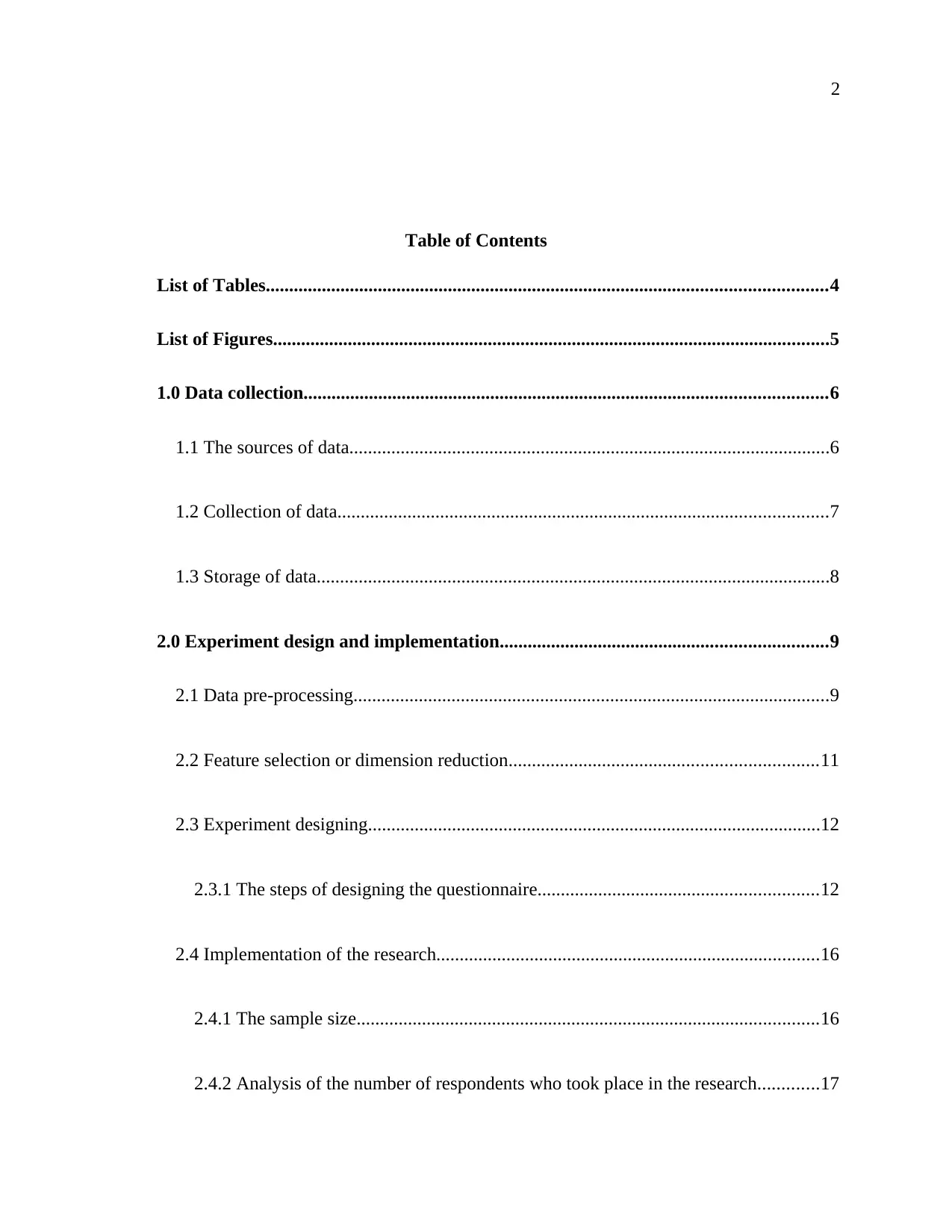
2
Table of Contents
List of Tables........................................................................................................................4
List of Figures.......................................................................................................................5
1.0 Data collection................................................................................................................6
1.1 The sources of data.......................................................................................................6
1.2 Collection of data.........................................................................................................7
1.3 Storage of data..............................................................................................................8
2.0 Experiment design and implementation......................................................................9
2.1 Data pre-processing......................................................................................................9
2.2 Feature selection or dimension reduction..................................................................11
2.3 Experiment designing.................................................................................................12
2.3.1 The steps of designing the questionnaire............................................................12
2.4 Implementation of the research..................................................................................16
2.4.1 The sample size...................................................................................................16
2.4.2 Analysis of the number of respondents who took place in the research.............17
Table of Contents
List of Tables........................................................................................................................4
List of Figures.......................................................................................................................5
1.0 Data collection................................................................................................................6
1.1 The sources of data.......................................................................................................6
1.2 Collection of data.........................................................................................................7
1.3 Storage of data..............................................................................................................8
2.0 Experiment design and implementation......................................................................9
2.1 Data pre-processing......................................................................................................9
2.2 Feature selection or dimension reduction..................................................................11
2.3 Experiment designing.................................................................................................12
2.3.1 The steps of designing the questionnaire............................................................12
2.4 Implementation of the research..................................................................................16
2.4.1 The sample size...................................................................................................16
2.4.2 Analysis of the number of respondents who took place in the research.............17
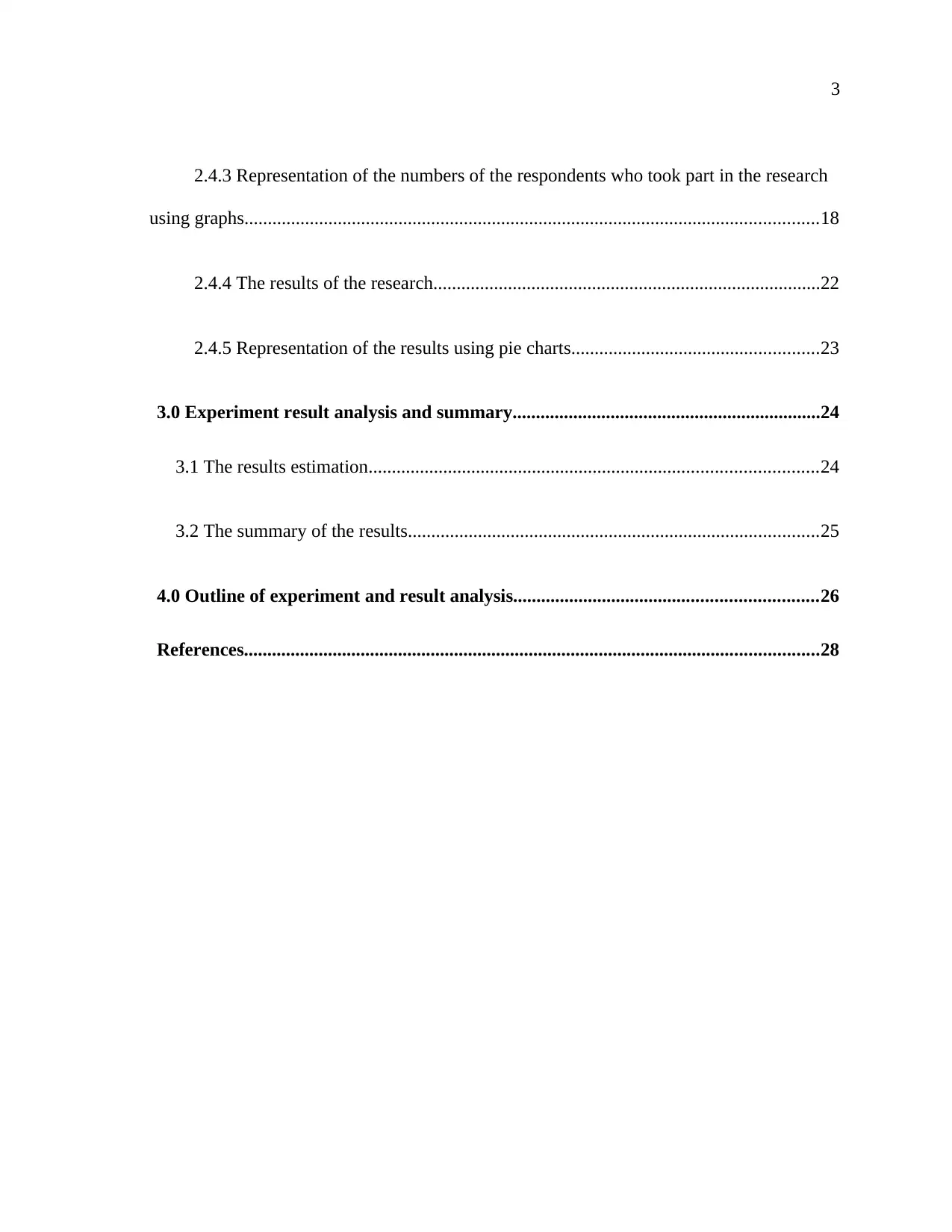
3
2.4.3 Representation of the numbers of the respondents who took part in the research
using graphs...........................................................................................................................18
2.4.4 The results of the research...................................................................................22
2.4.5 Representation of the results using pie charts.....................................................23
3.0 Experiment result analysis and summary..................................................................24
3.1 The results estimation................................................................................................24
3.2 The summary of the results........................................................................................25
4.0 Outline of experiment and result analysis.................................................................26
References...........................................................................................................................28
2.4.3 Representation of the numbers of the respondents who took part in the research
using graphs...........................................................................................................................18
2.4.4 The results of the research...................................................................................22
2.4.5 Representation of the results using pie charts.....................................................23
3.0 Experiment result analysis and summary..................................................................24
3.1 The results estimation................................................................................................24
3.2 The summary of the results........................................................................................25
4.0 Outline of experiment and result analysis.................................................................26
References...........................................................................................................................28

4
List of Tables
Table 1: Data collection table..............................................................................................5
Table 2: Data storage table..................................................................................................6
Table 3: A table of pre-processing, selection and reduction of data...............................9
Table 4: A table showing the classification of the respondents according to their
gender, age range, and background...........................................................................................11
Table 5: A table showing the numbers of the respondents who participated in the
research.........................................................................................................................................16
Table 6: A table showing the summary of the results of the research..........................20
List of Tables
Table 1: Data collection table..............................................................................................5
Table 2: Data storage table..................................................................................................6
Table 3: A table of pre-processing, selection and reduction of data...............................9
Table 4: A table showing the classification of the respondents according to their
gender, age range, and background...........................................................................................11
Table 5: A table showing the numbers of the respondents who participated in the
research.........................................................................................................................................16
Table 6: A table showing the summary of the results of the research..........................20
Secure Best Marks with AI Grader
Need help grading? Try our AI Grader for instant feedback on your assignments.
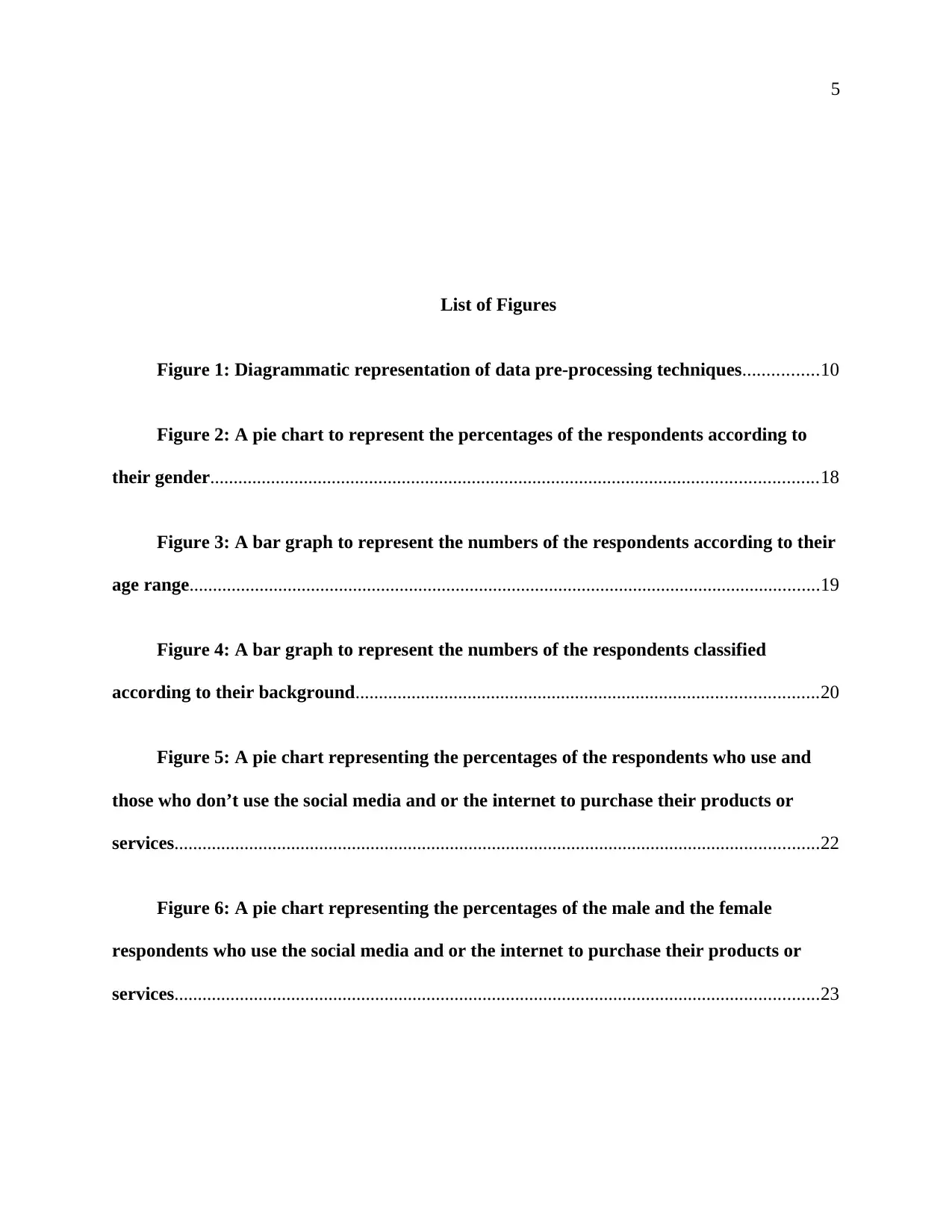
5
List of Figures
Figure 1: Diagrammatic representation of data pre-processing techniques................10
Figure 2: A pie chart to represent the percentages of the respondents according to
their gender..................................................................................................................................18
Figure 3: A bar graph to represent the numbers of the respondents according to their
age range.......................................................................................................................................19
Figure 4: A bar graph to represent the numbers of the respondents classified
according to their background...................................................................................................20
Figure 5: A pie chart representing the percentages of the respondents who use and
those who don’t use the social media and or the internet to purchase their products or
services..........................................................................................................................................22
Figure 6: A pie chart representing the percentages of the male and the female
respondents who use the social media and or the internet to purchase their products or
services..........................................................................................................................................23
List of Figures
Figure 1: Diagrammatic representation of data pre-processing techniques................10
Figure 2: A pie chart to represent the percentages of the respondents according to
their gender..................................................................................................................................18
Figure 3: A bar graph to represent the numbers of the respondents according to their
age range.......................................................................................................................................19
Figure 4: A bar graph to represent the numbers of the respondents classified
according to their background...................................................................................................20
Figure 5: A pie chart representing the percentages of the respondents who use and
those who don’t use the social media and or the internet to purchase their products or
services..........................................................................................................................................22
Figure 6: A pie chart representing the percentages of the male and the female
respondents who use the social media and or the internet to purchase their products or
services..........................................................................................................................................23
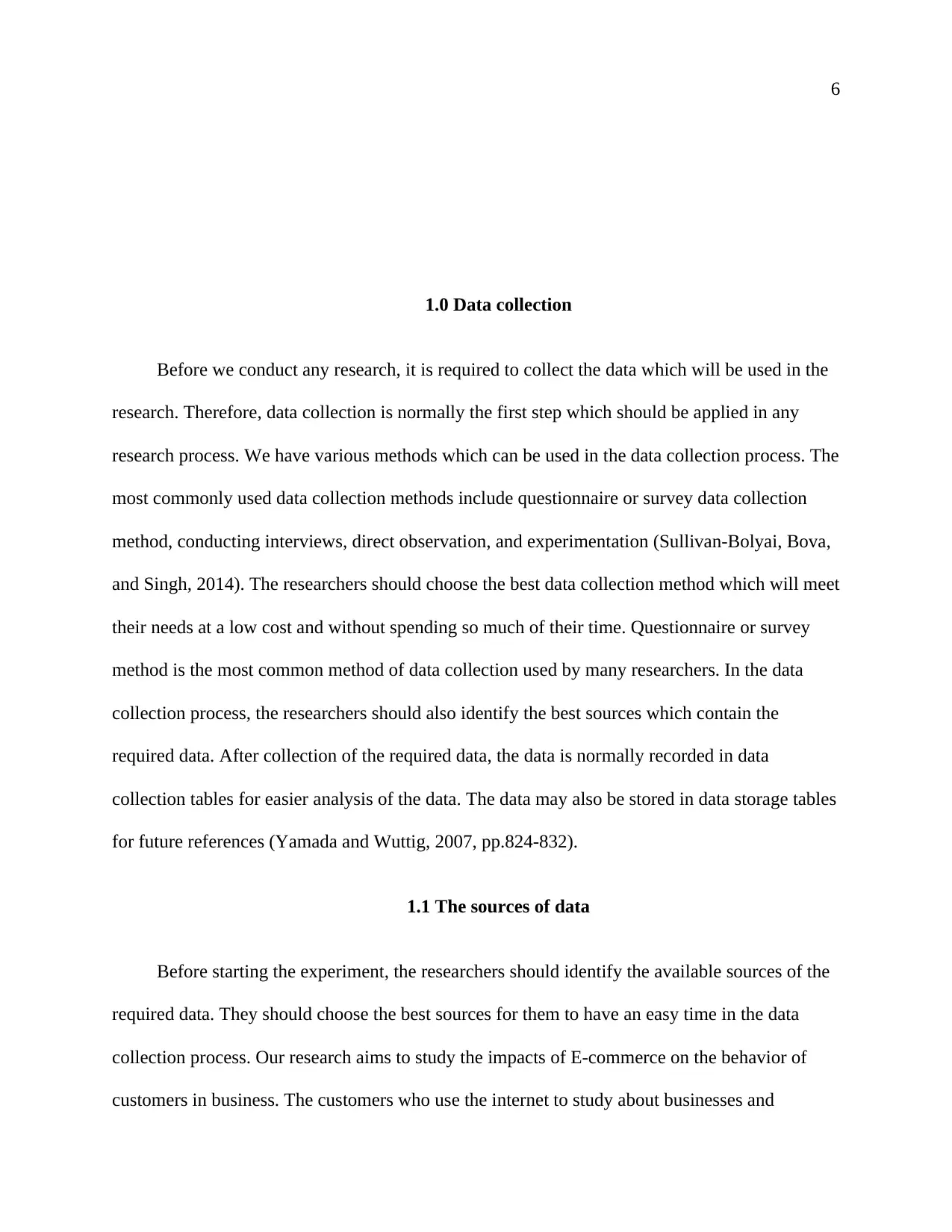
6
1.0 Data collection
Before we conduct any research, it is required to collect the data which will be used in the
research. Therefore, data collection is normally the first step which should be applied in any
research process. We have various methods which can be used in the data collection process. The
most commonly used data collection methods include questionnaire or survey data collection
method, conducting interviews, direct observation, and experimentation (Sullivan-Bolyai, Bova,
and Singh, 2014). The researchers should choose the best data collection method which will meet
their needs at a low cost and without spending so much of their time. Questionnaire or survey
method is the most common method of data collection used by many researchers. In the data
collection process, the researchers should also identify the best sources which contain the
required data. After collection of the required data, the data is normally recorded in data
collection tables for easier analysis of the data. The data may also be stored in data storage tables
for future references (Yamada and Wuttig, 2007, pp.824-832).
1.1 The sources of data
Before starting the experiment, the researchers should identify the available sources of the
required data. They should choose the best sources for them to have an easy time in the data
collection process. Our research aims to study the impacts of E-commerce on the behavior of
customers in business. The customers who use the internet to study about businesses and
1.0 Data collection
Before we conduct any research, it is required to collect the data which will be used in the
research. Therefore, data collection is normally the first step which should be applied in any
research process. We have various methods which can be used in the data collection process. The
most commonly used data collection methods include questionnaire or survey data collection
method, conducting interviews, direct observation, and experimentation (Sullivan-Bolyai, Bova,
and Singh, 2014). The researchers should choose the best data collection method which will meet
their needs at a low cost and without spending so much of their time. Questionnaire or survey
method is the most common method of data collection used by many researchers. In the data
collection process, the researchers should also identify the best sources which contain the
required data. After collection of the required data, the data is normally recorded in data
collection tables for easier analysis of the data. The data may also be stored in data storage tables
for future references (Yamada and Wuttig, 2007, pp.824-832).
1.1 The sources of data
Before starting the experiment, the researchers should identify the available sources of the
required data. They should choose the best sources for them to have an easy time in the data
collection process. Our research aims to study the impacts of E-commerce on the behavior of
customers in business. The customers who use the internet to study about businesses and

7
purchase their products or services over the internet can be found in malls, in businesses which
use E-commerce services, in institutions, in the social media or many other places or
organizations. Therefore, the malls, the businesses which use E-commerce services, the
institutions, and the social media will be the main sources of the data to be used in our research.
1.2 Collection of data
After identifying the best sources of data, the researchers should go to the field to collect
the required data. In our research, we shall collect data from various malls, businesses,
institutions, and other places or organizations such as people’s parks or supermarkets within
Australia. We shall also use the social media to gather some data. The data is collected and
recorded in tables before it can be used in the experimental research. A sample table which can
be used to record the collected data is shown below:
Table 1: Data collection table
Data
source
name
Source
(malls,
businesses,
institutions,
and social
media)
Data description Data file
format
Charge fee Target
data
source
Data 1 Malls How many customers
use malls which offer E-
commerce services?
Txt Free Yes
Data 2 Businesses How many customers
use businesses which
offer E-commerce
services?
Txt Free Yes
Data 3 Institutions How many students
attend to institutions
Txt Free Yes
purchase their products or services over the internet can be found in malls, in businesses which
use E-commerce services, in institutions, in the social media or many other places or
organizations. Therefore, the malls, the businesses which use E-commerce services, the
institutions, and the social media will be the main sources of the data to be used in our research.
1.2 Collection of data
After identifying the best sources of data, the researchers should go to the field to collect
the required data. In our research, we shall collect data from various malls, businesses,
institutions, and other places or organizations such as people’s parks or supermarkets within
Australia. We shall also use the social media to gather some data. The data is collected and
recorded in tables before it can be used in the experimental research. A sample table which can
be used to record the collected data is shown below:
Table 1: Data collection table
Data
source
name
Source
(malls,
businesses,
institutions,
and social
media)
Data description Data file
format
Charge fee Target
data
source
Data 1 Malls How many customers
use malls which offer E-
commerce services?
Txt Free Yes
Data 2 Businesses How many customers
use businesses which
offer E-commerce
services?
Txt Free Yes
Data 3 Institutions How many students
attend to institutions
Txt Free Yes
Paraphrase This Document
Need a fresh take? Get an instant paraphrase of this document with our AI Paraphraser
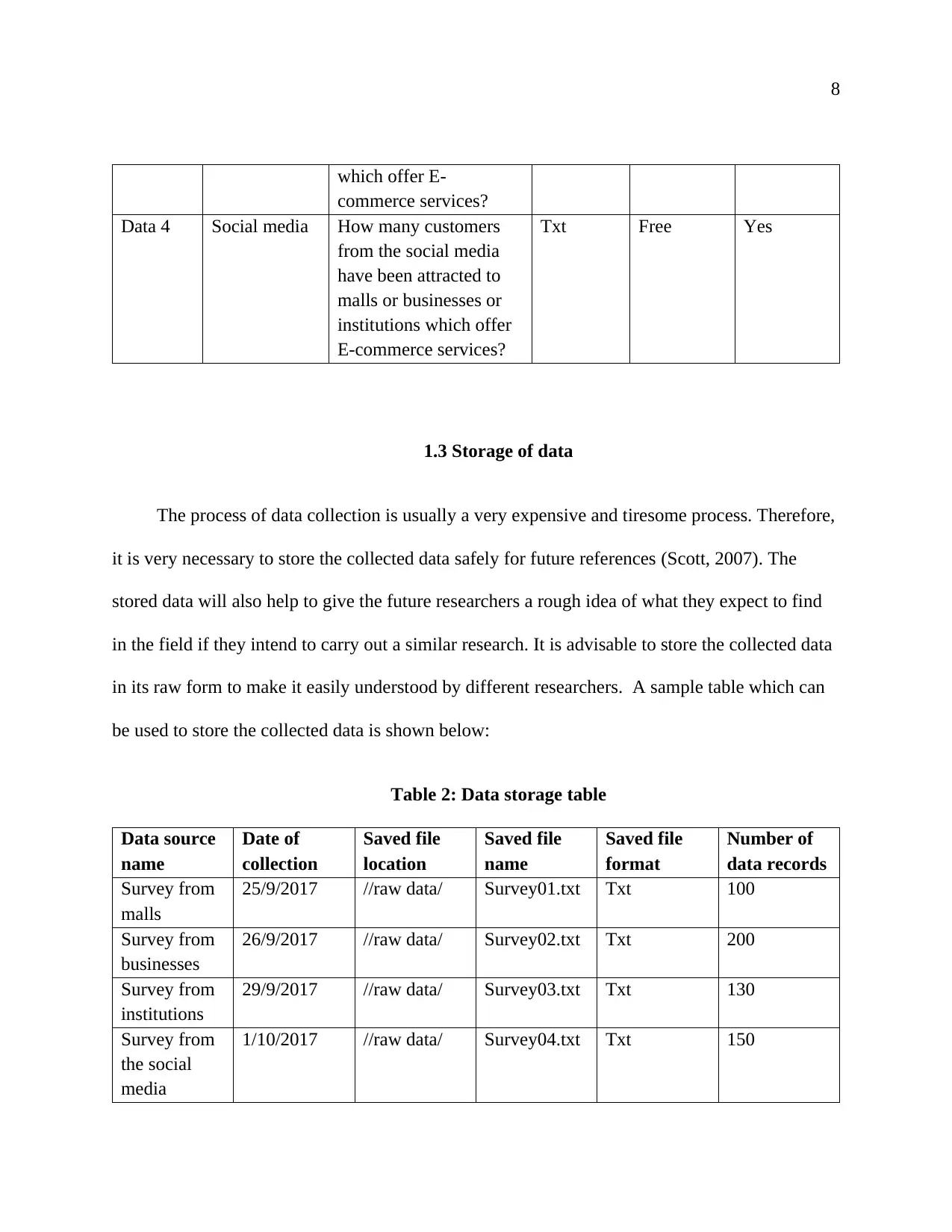
8
which offer E-
commerce services?
Data 4 Social media How many customers
from the social media
have been attracted to
malls or businesses or
institutions which offer
E-commerce services?
Txt Free Yes
1.3 Storage of data
The process of data collection is usually a very expensive and tiresome process. Therefore,
it is very necessary to store the collected data safely for future references (Scott, 2007). The
stored data will also help to give the future researchers a rough idea of what they expect to find
in the field if they intend to carry out a similar research. It is advisable to store the collected data
in its raw form to make it easily understood by different researchers. A sample table which can
be used to store the collected data is shown below:
Table 2: Data storage table
Data source
name
Date of
collection
Saved file
location
Saved file
name
Saved file
format
Number of
data records
Survey from
malls
25/9/2017 //raw data/ Survey01.txt Txt 100
Survey from
businesses
26/9/2017 //raw data/ Survey02.txt Txt 200
Survey from
institutions
29/9/2017 //raw data/ Survey03.txt Txt 130
Survey from
the social
media
1/10/2017 //raw data/ Survey04.txt Txt 150
which offer E-
commerce services?
Data 4 Social media How many customers
from the social media
have been attracted to
malls or businesses or
institutions which offer
E-commerce services?
Txt Free Yes
1.3 Storage of data
The process of data collection is usually a very expensive and tiresome process. Therefore,
it is very necessary to store the collected data safely for future references (Scott, 2007). The
stored data will also help to give the future researchers a rough idea of what they expect to find
in the field if they intend to carry out a similar research. It is advisable to store the collected data
in its raw form to make it easily understood by different researchers. A sample table which can
be used to store the collected data is shown below:
Table 2: Data storage table
Data source
name
Date of
collection
Saved file
location
Saved file
name
Saved file
format
Number of
data records
Survey from
malls
25/9/2017 //raw data/ Survey01.txt Txt 100
Survey from
businesses
26/9/2017 //raw data/ Survey02.txt Txt 200
Survey from
institutions
29/9/2017 //raw data/ Survey03.txt Txt 130
Survey from
the social
media
1/10/2017 //raw data/ Survey04.txt Txt 150
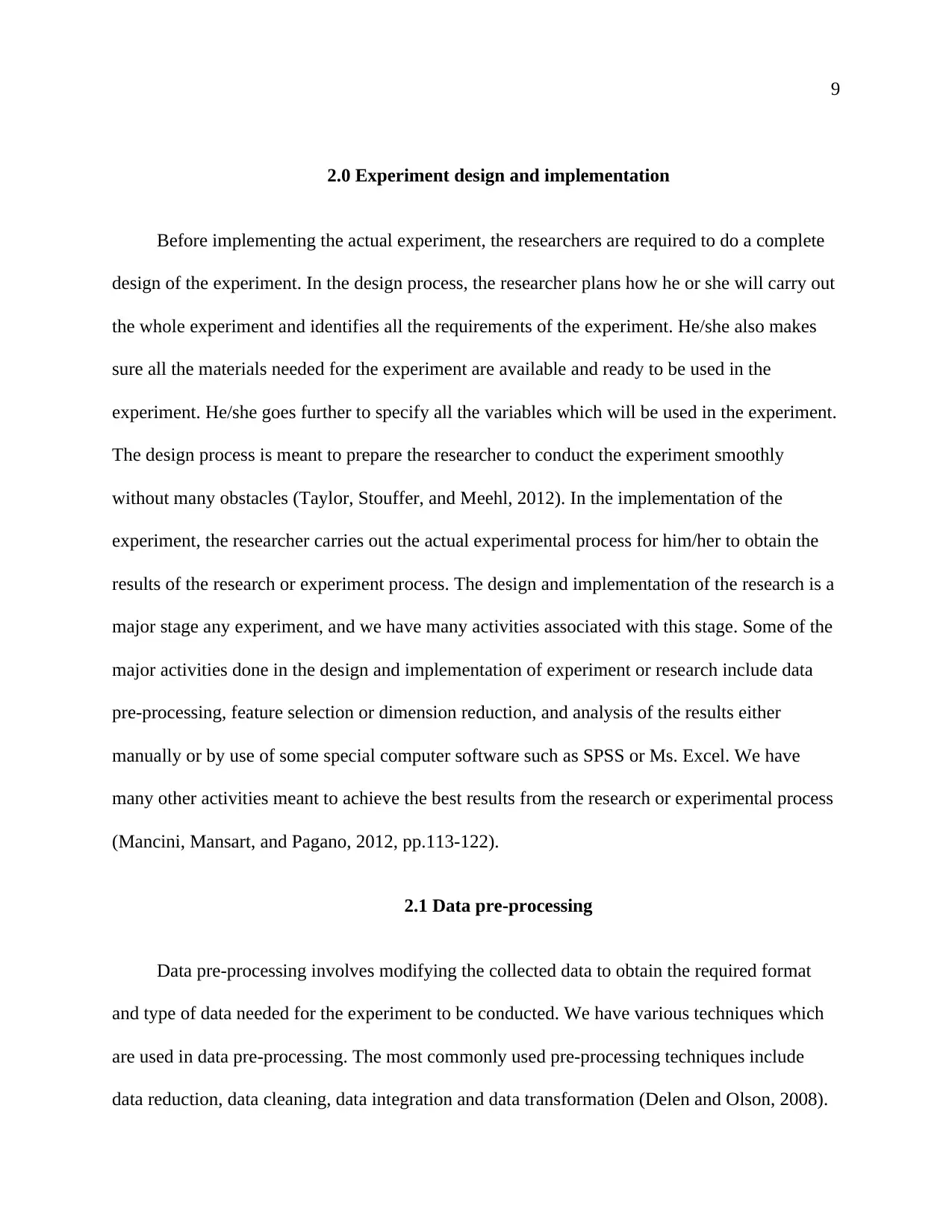
9
2.0 Experiment design and implementation
Before implementing the actual experiment, the researchers are required to do a complete
design of the experiment. In the design process, the researcher plans how he or she will carry out
the whole experiment and identifies all the requirements of the experiment. He/she also makes
sure all the materials needed for the experiment are available and ready to be used in the
experiment. He/she goes further to specify all the variables which will be used in the experiment.
The design process is meant to prepare the researcher to conduct the experiment smoothly
without many obstacles (Taylor, Stouffer, and Meehl, 2012). In the implementation of the
experiment, the researcher carries out the actual experimental process for him/her to obtain the
results of the research or experiment process. The design and implementation of the research is a
major stage any experiment, and we have many activities associated with this stage. Some of the
major activities done in the design and implementation of experiment or research include data
pre-processing, feature selection or dimension reduction, and analysis of the results either
manually or by use of some special computer software such as SPSS or Ms. Excel. We have
many other activities meant to achieve the best results from the research or experimental process
(Mancini, Mansart, and Pagano, 2012, pp.113-122).
2.1 Data pre-processing
Data pre-processing involves modifying the collected data to obtain the required format
and type of data needed for the experiment to be conducted. We have various techniques which
are used in data pre-processing. The most commonly used pre-processing techniques include
data reduction, data cleaning, data integration and data transformation (Delen and Olson, 2008).
2.0 Experiment design and implementation
Before implementing the actual experiment, the researchers are required to do a complete
design of the experiment. In the design process, the researcher plans how he or she will carry out
the whole experiment and identifies all the requirements of the experiment. He/she also makes
sure all the materials needed for the experiment are available and ready to be used in the
experiment. He/she goes further to specify all the variables which will be used in the experiment.
The design process is meant to prepare the researcher to conduct the experiment smoothly
without many obstacles (Taylor, Stouffer, and Meehl, 2012). In the implementation of the
experiment, the researcher carries out the actual experimental process for him/her to obtain the
results of the research or experiment process. The design and implementation of the research is a
major stage any experiment, and we have many activities associated with this stage. Some of the
major activities done in the design and implementation of experiment or research include data
pre-processing, feature selection or dimension reduction, and analysis of the results either
manually or by use of some special computer software such as SPSS or Ms. Excel. We have
many other activities meant to achieve the best results from the research or experimental process
(Mancini, Mansart, and Pagano, 2012, pp.113-122).
2.1 Data pre-processing
Data pre-processing involves modifying the collected data to obtain the required format
and type of data needed for the experiment to be conducted. We have various techniques which
are used in data pre-processing. The most commonly used pre-processing techniques include
data reduction, data cleaning, data integration and data transformation (Delen and Olson, 2008).
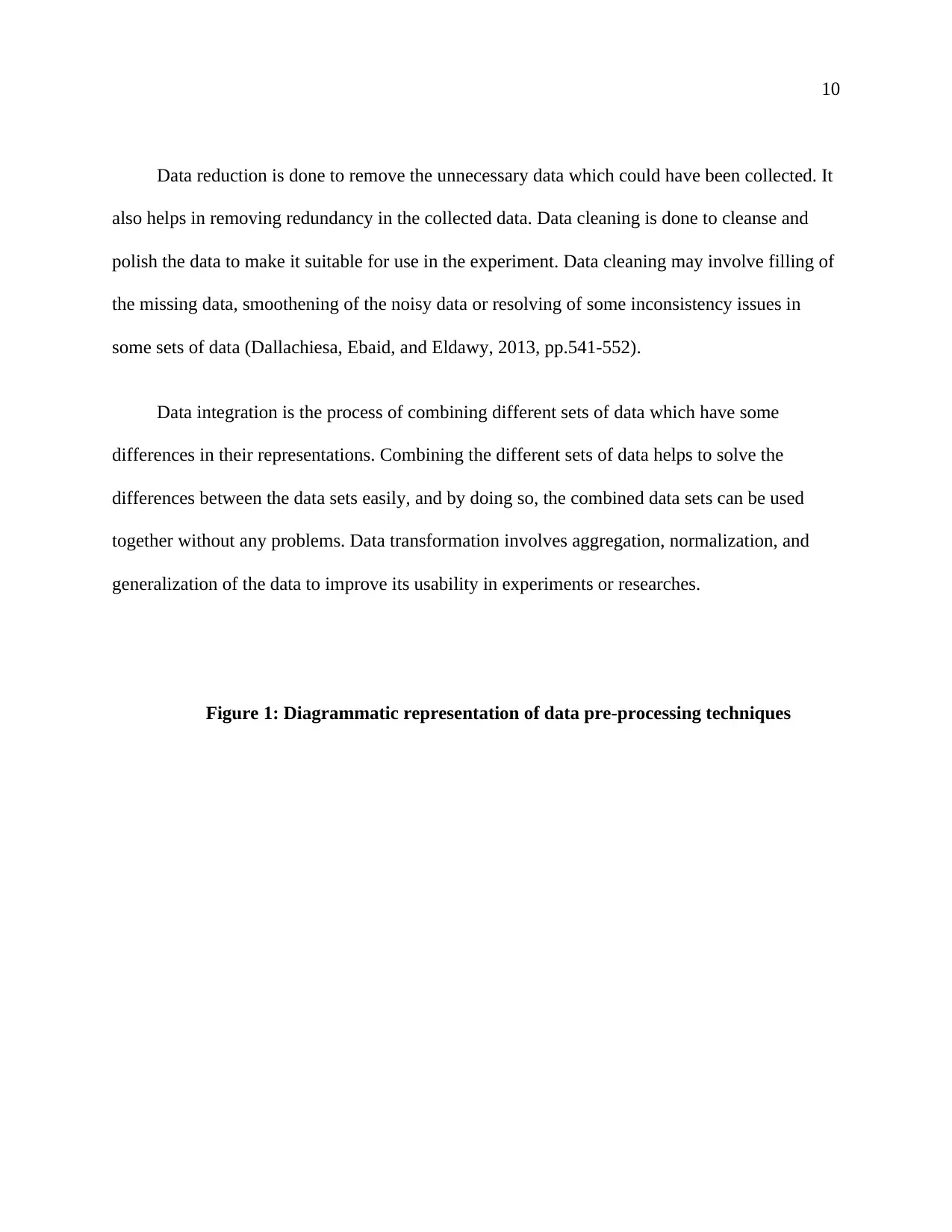
10
Data reduction is done to remove the unnecessary data which could have been collected. It
also helps in removing redundancy in the collected data. Data cleaning is done to cleanse and
polish the data to make it suitable for use in the experiment. Data cleaning may involve filling of
the missing data, smoothening of the noisy data or resolving of some inconsistency issues in
some sets of data (Dallachiesa, Ebaid, and Eldawy, 2013, pp.541-552).
Data integration is the process of combining different sets of data which have some
differences in their representations. Combining the different sets of data helps to solve the
differences between the data sets easily, and by doing so, the combined data sets can be used
together without any problems. Data transformation involves aggregation, normalization, and
generalization of the data to improve its usability in experiments or researches.
Figure 1: Diagrammatic representation of data pre-processing techniques
Data reduction is done to remove the unnecessary data which could have been collected. It
also helps in removing redundancy in the collected data. Data cleaning is done to cleanse and
polish the data to make it suitable for use in the experiment. Data cleaning may involve filling of
the missing data, smoothening of the noisy data or resolving of some inconsistency issues in
some sets of data (Dallachiesa, Ebaid, and Eldawy, 2013, pp.541-552).
Data integration is the process of combining different sets of data which have some
differences in their representations. Combining the different sets of data helps to solve the
differences between the data sets easily, and by doing so, the combined data sets can be used
together without any problems. Data transformation involves aggregation, normalization, and
generalization of the data to improve its usability in experiments or researches.
Figure 1: Diagrammatic representation of data pre-processing techniques
Secure Best Marks with AI Grader
Need help grading? Try our AI Grader for instant feedback on your assignments.
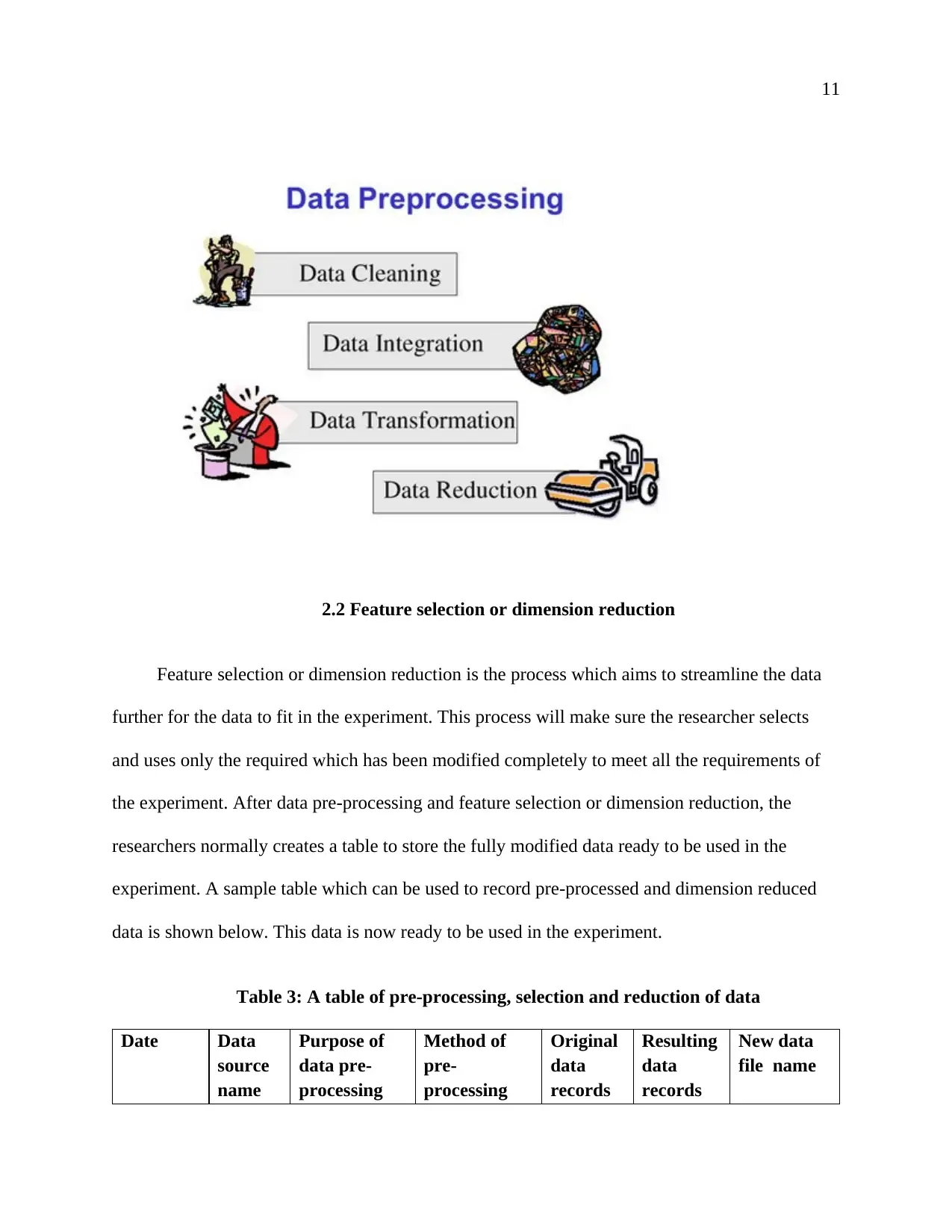
11
2.2 Feature selection or dimension reduction
Feature selection or dimension reduction is the process which aims to streamline the data
further for the data to fit in the experiment. This process will make sure the researcher selects
and uses only the required which has been modified completely to meet all the requirements of
the experiment. After data pre-processing and feature selection or dimension reduction, the
researchers normally creates a table to store the fully modified data ready to be used in the
experiment. A sample table which can be used to record pre-processed and dimension reduced
data is shown below. This data is now ready to be used in the experiment.
Table 3: A table of pre-processing, selection and reduction of data
Date Data
source
name
Purpose of
data pre-
processing
Method of
pre-
processing
Original
data
records
Resulting
data
records
New data
file name
2.2 Feature selection or dimension reduction
Feature selection or dimension reduction is the process which aims to streamline the data
further for the data to fit in the experiment. This process will make sure the researcher selects
and uses only the required which has been modified completely to meet all the requirements of
the experiment. After data pre-processing and feature selection or dimension reduction, the
researchers normally creates a table to store the fully modified data ready to be used in the
experiment. A sample table which can be used to record pre-processed and dimension reduced
data is shown below. This data is now ready to be used in the experiment.
Table 3: A table of pre-processing, selection and reduction of data
Date Data
source
name
Purpose of
data pre-
processing
Method of
pre-
processing
Original
data
records
Resulting
data
records
New data
file name
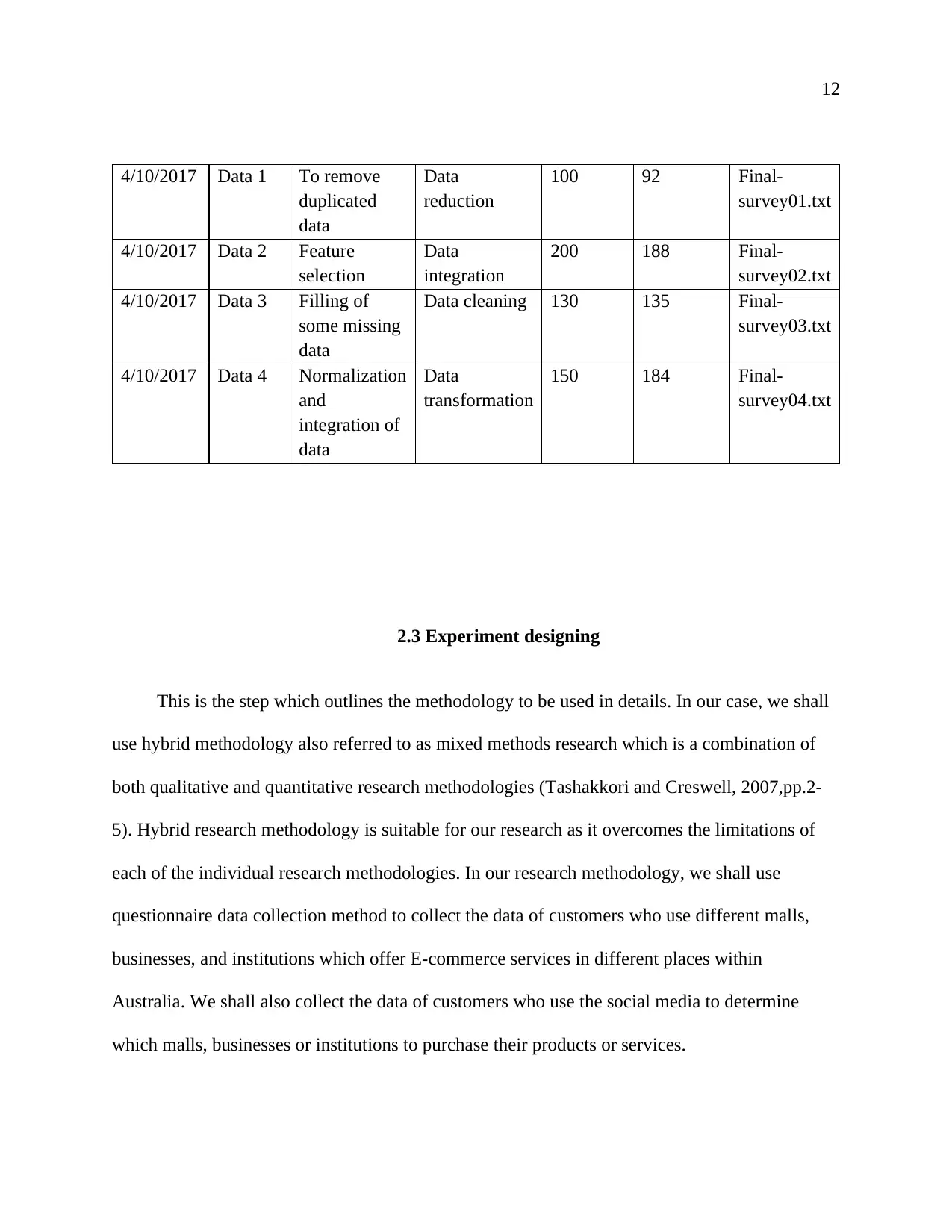
12
4/10/2017 Data 1 To remove
duplicated
data
Data
reduction
100 92 Final-
survey01.txt
4/10/2017 Data 2 Feature
selection
Data
integration
200 188 Final-
survey02.txt
4/10/2017 Data 3 Filling of
some missing
data
Data cleaning 130 135 Final-
survey03.txt
4/10/2017 Data 4 Normalization
and
integration of
data
Data
transformation
150 184 Final-
survey04.txt
2.3 Experiment designing
This is the step which outlines the methodology to be used in details. In our case, we shall
use hybrid methodology also referred to as mixed methods research which is a combination of
both qualitative and quantitative research methodologies (Tashakkori and Creswell, 2007,pp.2-
5). Hybrid research methodology is suitable for our research as it overcomes the limitations of
each of the individual research methodologies. In our research methodology, we shall use
questionnaire data collection method to collect the data of customers who use different malls,
businesses, and institutions which offer E-commerce services in different places within
Australia. We shall also collect the data of customers who use the social media to determine
which malls, businesses or institutions to purchase their products or services.
4/10/2017 Data 1 To remove
duplicated
data
Data
reduction
100 92 Final-
survey01.txt
4/10/2017 Data 2 Feature
selection
Data
integration
200 188 Final-
survey02.txt
4/10/2017 Data 3 Filling of
some missing
data
Data cleaning 130 135 Final-
survey03.txt
4/10/2017 Data 4 Normalization
and
integration of
data
Data
transformation
150 184 Final-
survey04.txt
2.3 Experiment designing
This is the step which outlines the methodology to be used in details. In our case, we shall
use hybrid methodology also referred to as mixed methods research which is a combination of
both qualitative and quantitative research methodologies (Tashakkori and Creswell, 2007,pp.2-
5). Hybrid research methodology is suitable for our research as it overcomes the limitations of
each of the individual research methodologies. In our research methodology, we shall use
questionnaire data collection method to collect the data of customers who use different malls,
businesses, and institutions which offer E-commerce services in different places within
Australia. We shall also collect the data of customers who use the social media to determine
which malls, businesses or institutions to purchase their products or services.
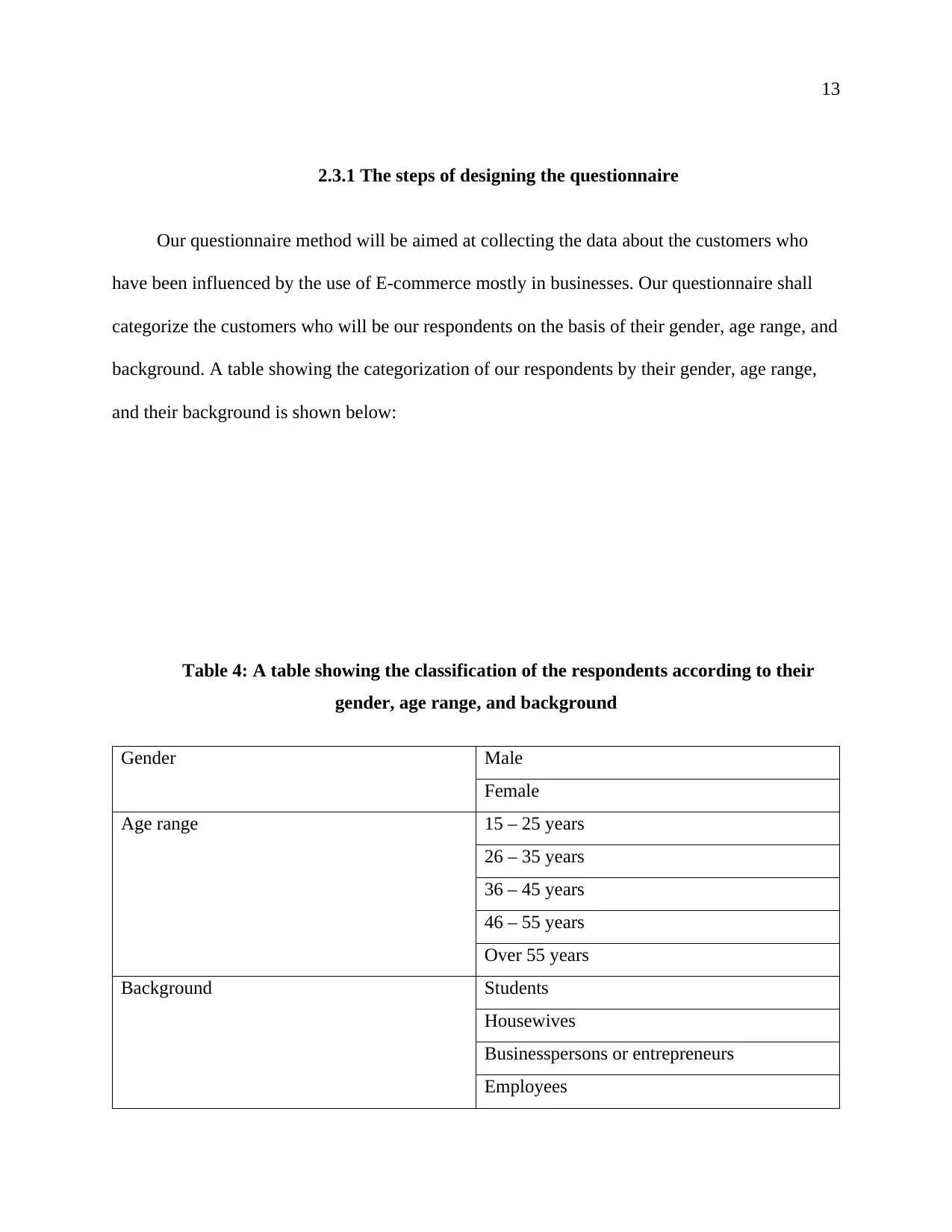
13
2.3.1 The steps of designing the questionnaire
Our questionnaire method will be aimed at collecting the data about the customers who
have been influenced by the use of E-commerce mostly in businesses. Our questionnaire shall
categorize the customers who will be our respondents on the basis of their gender, age range, and
background. A table showing the categorization of our respondents by their gender, age range,
and their background is shown below:
Table 4: A table showing the classification of the respondents according to their
gender, age range, and background
Gender Male
Female
Age range 15 – 25 years
26 – 35 years
36 – 45 years
46 – 55 years
Over 55 years
Background Students
Housewives
Businesspersons or entrepreneurs
Employees
2.3.1 The steps of designing the questionnaire
Our questionnaire method will be aimed at collecting the data about the customers who
have been influenced by the use of E-commerce mostly in businesses. Our questionnaire shall
categorize the customers who will be our respondents on the basis of their gender, age range, and
background. A table showing the categorization of our respondents by their gender, age range,
and their background is shown below:
Table 4: A table showing the classification of the respondents according to their
gender, age range, and background
Gender Male
Female
Age range 15 – 25 years
26 – 35 years
36 – 45 years
46 – 55 years
Over 55 years
Background Students
Housewives
Businesspersons or entrepreneurs
Employees
Paraphrase This Document
Need a fresh take? Get an instant paraphrase of this document with our AI Paraphraser

14
Others
After categorizing our respondents, we should give them the questionnaire forms to be
filled for them to provide the required information. A sample questionnaire form which can be
used to collect the required data is shown below:
A questionnaire form which can be used in data collection in our research
Please provide correct information. We value your feedback, and we
shall keep it confidential
Date ………………
1. What is your name?
.............................................................................................................
Others
After categorizing our respondents, we should give them the questionnaire forms to be
filled for them to provide the required information. A sample questionnaire form which can be
used to collect the required data is shown below:
A questionnaire form which can be used in data collection in our research
Please provide correct information. We value your feedback, and we
shall keep it confidential
Date ………………
1. What is your name?
.............................................................................................................

15
2. What is your gender? (please tick accordingly)
Male Female Other
3. What is your age bracket? (please tick accordingly)
15 -25 Years 26 – 35 Years 36 – 45 Years 46 – 55 Years Over 55 Years
4. What is your background? (please tick accordingly)
Student Housewife Entrepreneur Employee Others
5. Do you use the social media or the internet to purchase your products or services?
Yes No
6. (a) Do you purchase your products or services from malls which offer E-commerce
services?
Yes No
2. What is your gender? (please tick accordingly)
Male Female Other
3. What is your age bracket? (please tick accordingly)
15 -25 Years 26 – 35 Years 36 – 45 Years 46 – 55 Years Over 55 Years
4. What is your background? (please tick accordingly)
Student Housewife Entrepreneur Employee Others
5. Do you use the social media or the internet to purchase your products or services?
Yes No
6. (a) Do you purchase your products or services from malls which offer E-commerce
services?
Yes No

16
(b) If yes, which malls do you purchase your products or services? (Please state all the
malls you have ever used)
.....................................................................................................................................
.....................................................................................................................................
.....................................................................................................................................
.....................................................................................................................................
.....................................................................................................................................
.....................................................................................................................................
.....................................................................................................................................
7. (a) Do you purchase your products or services from businesses which offer E-
commerce services?
Yes No
(b) If yes, which businesses do you purchase your products or services? (Please state
all the businesses you have ever used)
.....................................................................................................................................
.....................................................................................................................................
.....................................................................................................................................
.....................................................................................................................................
.....................................................................................................................................
.....................................................................................................................................
....................................................................................................................................
(Thank you for your honest feedback)
(b) If yes, which malls do you purchase your products or services? (Please state all the
malls you have ever used)
.....................................................................................................................................
.....................................................................................................................................
.....................................................................................................................................
.....................................................................................................................................
.....................................................................................................................................
.....................................................................................................................................
.....................................................................................................................................
7. (a) Do you purchase your products or services from businesses which offer E-
commerce services?
Yes No
(b) If yes, which businesses do you purchase your products or services? (Please state
all the businesses you have ever used)
.....................................................................................................................................
.....................................................................................................................................
.....................................................................................................................................
.....................................................................................................................................
.....................................................................................................................................
.....................................................................................................................................
....................................................................................................................................
(Thank you for your honest feedback)
Secure Best Marks with AI Grader
Need help grading? Try our AI Grader for instant feedback on your assignments.
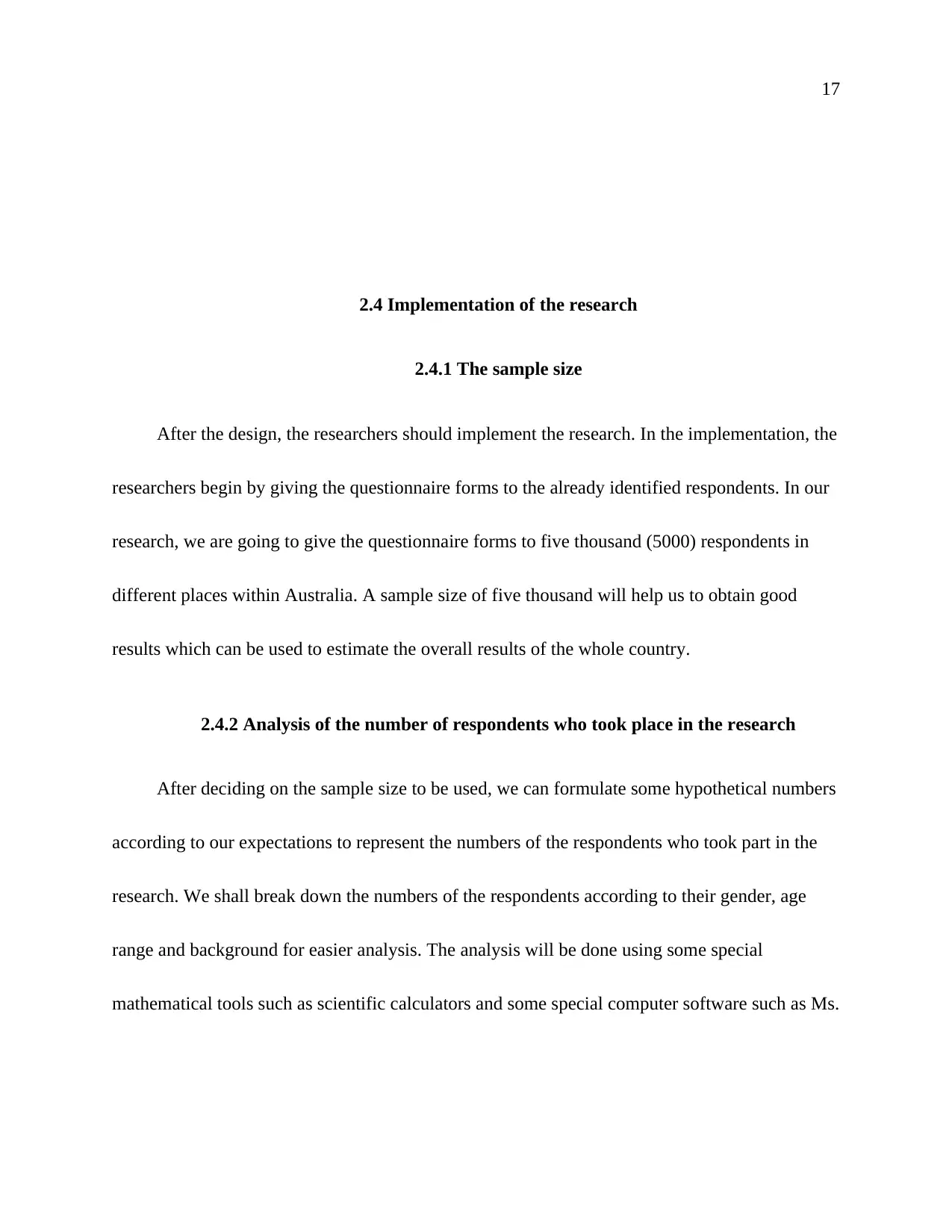
17
2.4 Implementation of the research
2.4.1 The sample size
After the design, the researchers should implement the research. In the implementation, the
researchers begin by giving the questionnaire forms to the already identified respondents. In our
research, we are going to give the questionnaire forms to five thousand (5000) respondents in
different places within Australia. A sample size of five thousand will help us to obtain good
results which can be used to estimate the overall results of the whole country.
2.4.2 Analysis of the number of respondents who took place in the research
After deciding on the sample size to be used, we can formulate some hypothetical numbers
according to our expectations to represent the numbers of the respondents who took part in the
research. We shall break down the numbers of the respondents according to their gender, age
range and background for easier analysis. The analysis will be done using some special
mathematical tools such as scientific calculators and some special computer software such as Ms.
2.4 Implementation of the research
2.4.1 The sample size
After the design, the researchers should implement the research. In the implementation, the
researchers begin by giving the questionnaire forms to the already identified respondents. In our
research, we are going to give the questionnaire forms to five thousand (5000) respondents in
different places within Australia. A sample size of five thousand will help us to obtain good
results which can be used to estimate the overall results of the whole country.
2.4.2 Analysis of the number of respondents who took place in the research
After deciding on the sample size to be used, we can formulate some hypothetical numbers
according to our expectations to represent the numbers of the respondents who took part in the
research. We shall break down the numbers of the respondents according to their gender, age
range and background for easier analysis. The analysis will be done using some special
mathematical tools such as scientific calculators and some special computer software such as Ms.
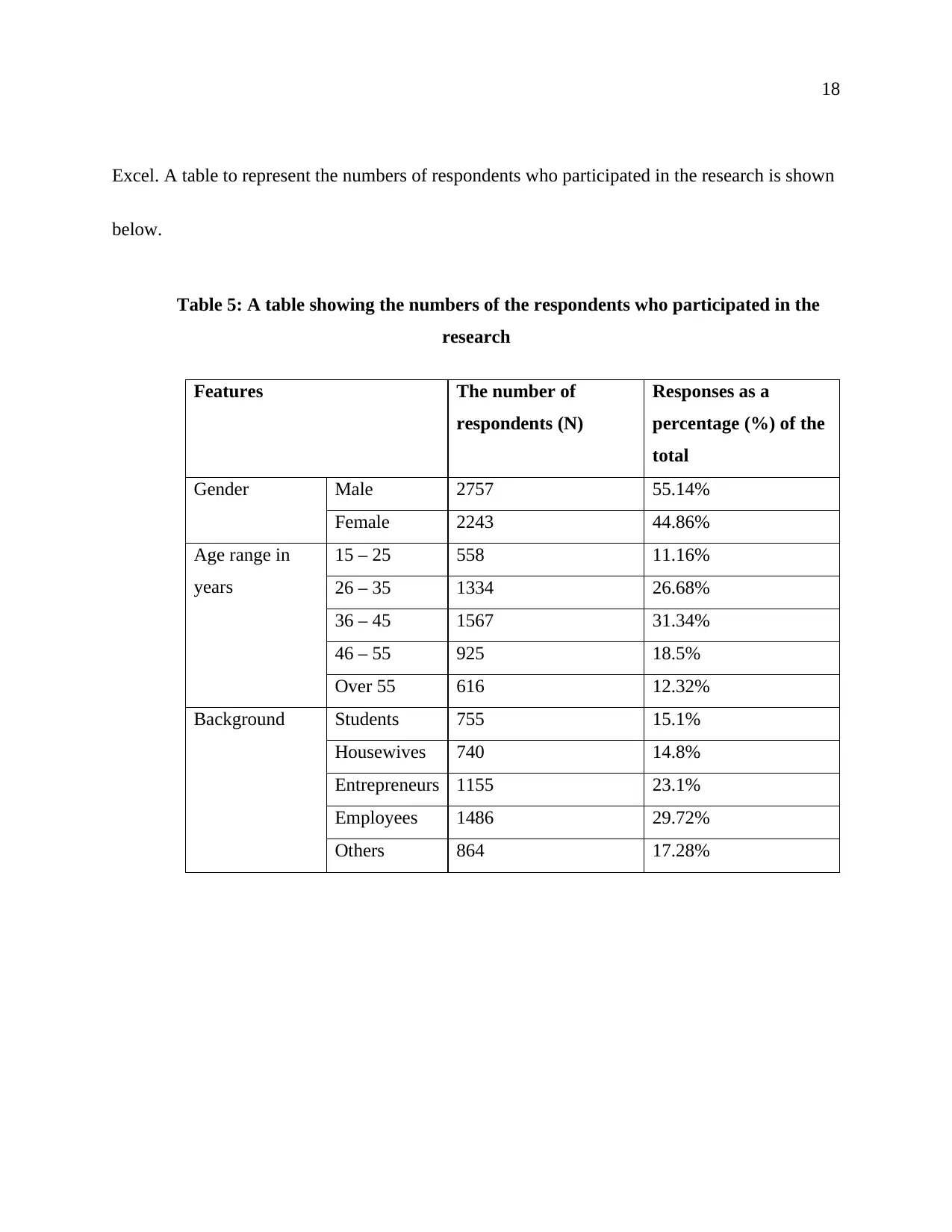
18
Excel. A table to represent the numbers of respondents who participated in the research is shown
below.
Table 5: A table showing the numbers of the respondents who participated in the
research
Features The number of
respondents (N)
Responses as a
percentage (%) of the
total
Gender Male 2757 55.14%
Female 2243 44.86%
Age range in
years
15 – 25 558 11.16%
26 – 35 1334 26.68%
36 – 45 1567 31.34%
46 – 55 925 18.5%
Over 55 616 12.32%
Background Students 755 15.1%
Housewives 740 14.8%
Entrepreneurs 1155 23.1%
Employees 1486 29.72%
Others 864 17.28%
Excel. A table to represent the numbers of respondents who participated in the research is shown
below.
Table 5: A table showing the numbers of the respondents who participated in the
research
Features The number of
respondents (N)
Responses as a
percentage (%) of the
total
Gender Male 2757 55.14%
Female 2243 44.86%
Age range in
years
15 – 25 558 11.16%
26 – 35 1334 26.68%
36 – 45 1567 31.34%
46 – 55 925 18.5%
Over 55 616 12.32%
Background Students 755 15.1%
Housewives 740 14.8%
Entrepreneurs 1155 23.1%
Employees 1486 29.72%
Others 864 17.28%
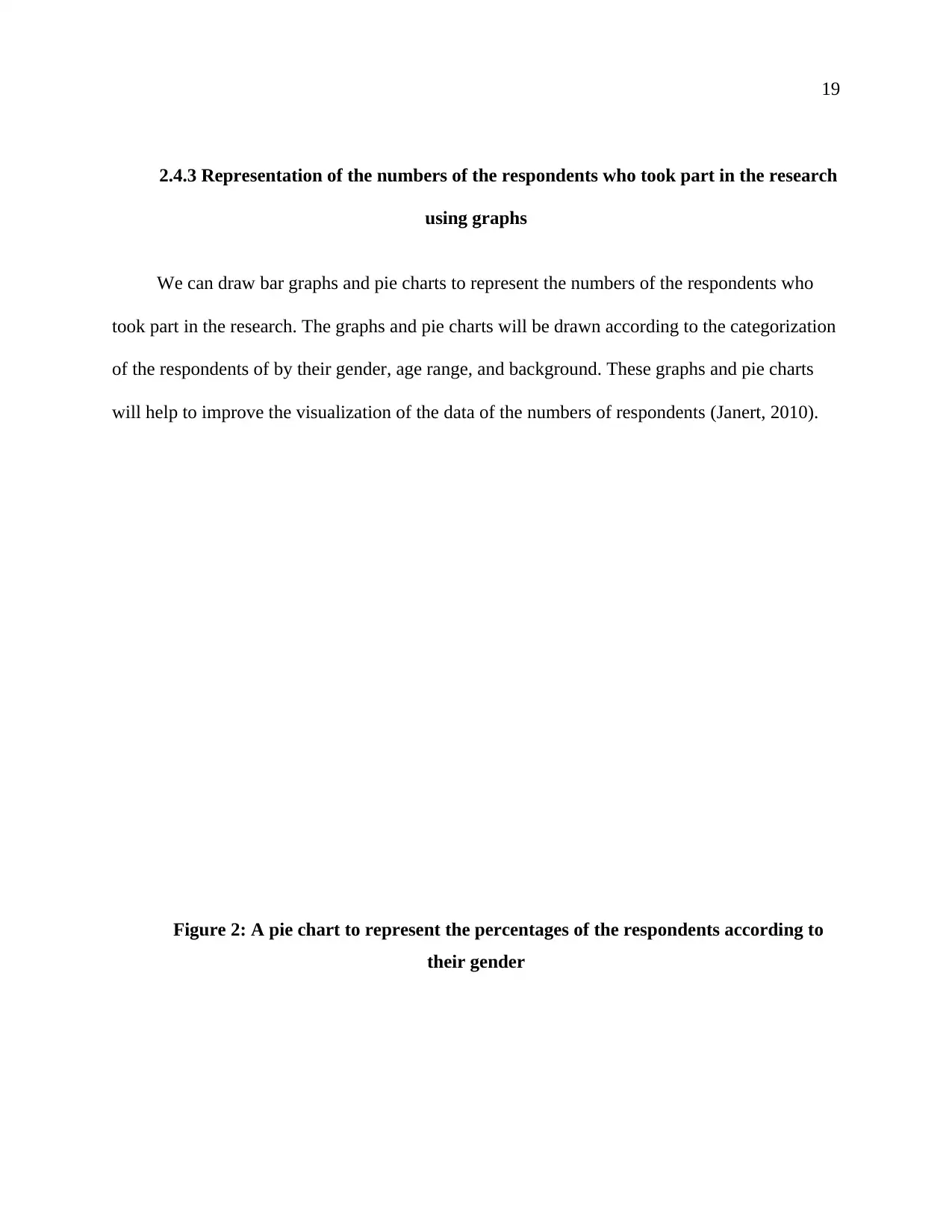
19
2.4.3 Representation of the numbers of the respondents who took part in the research
using graphs
We can draw bar graphs and pie charts to represent the numbers of the respondents who
took part in the research. The graphs and pie charts will be drawn according to the categorization
of the respondents of by their gender, age range, and background. These graphs and pie charts
will help to improve the visualization of the data of the numbers of respondents (Janert, 2010).
Figure 2: A pie chart to represent the percentages of the respondents according to
their gender
2.4.3 Representation of the numbers of the respondents who took part in the research
using graphs
We can draw bar graphs and pie charts to represent the numbers of the respondents who
took part in the research. The graphs and pie charts will be drawn according to the categorization
of the respondents of by their gender, age range, and background. These graphs and pie charts
will help to improve the visualization of the data of the numbers of respondents (Janert, 2010).
Figure 2: A pie chart to represent the percentages of the respondents according to
their gender
Paraphrase This Document
Need a fresh take? Get an instant paraphrase of this document with our AI Paraphraser
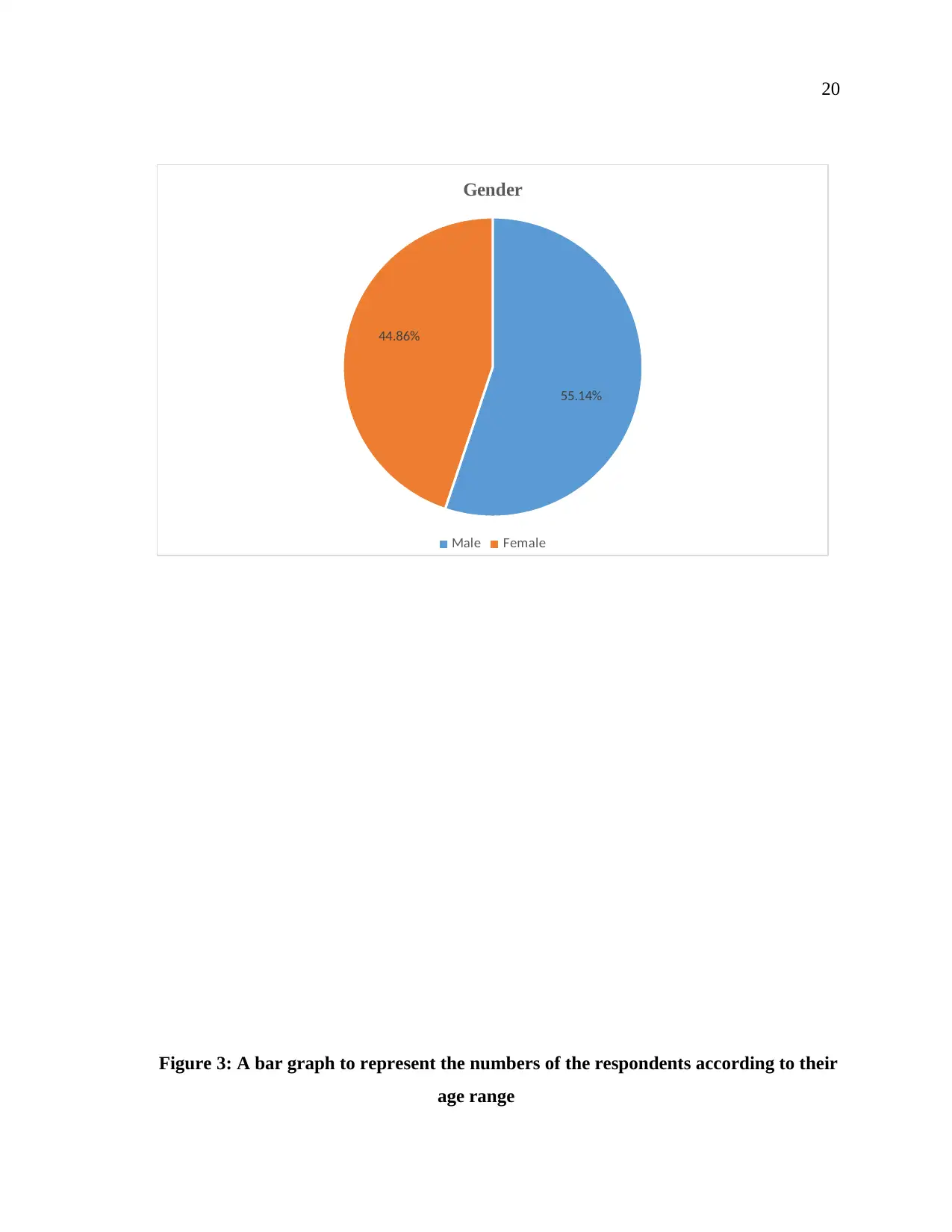
20
55.14%
44.86%
Gender
Male Female
Figure 3: A bar graph to represent the numbers of the respondents according to their
age range
55.14%
44.86%
Gender
Male Female
Figure 3: A bar graph to represent the numbers of the respondents according to their
age range
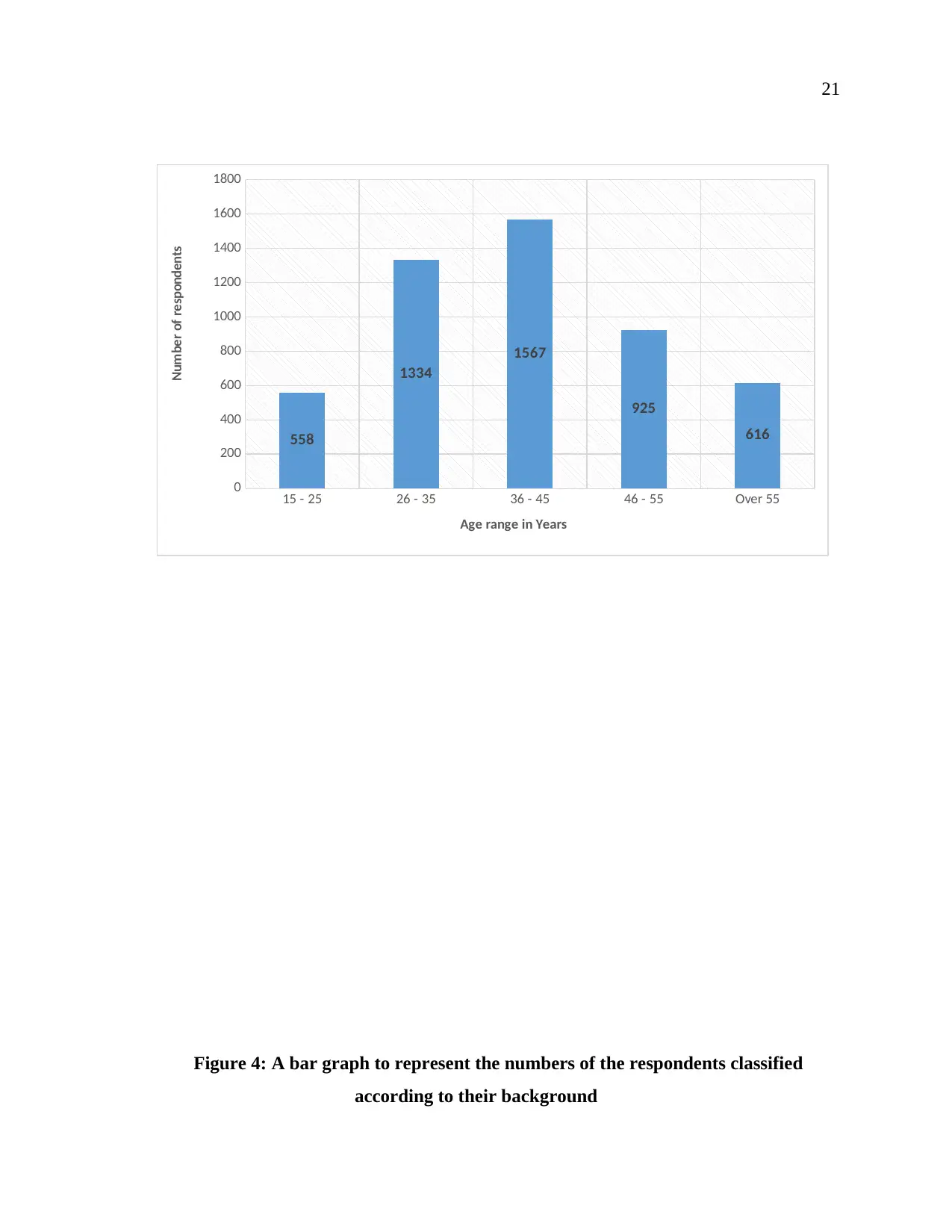
21
15 - 25 26 - 35 36 - 45 46 - 55 Over 55
0
200
400
600
800
1000
1200
1400
1600
1800
558
1334
1567
925
616
Age range in Years
Number of respondents
Figure 4: A bar graph to represent the numbers of the respondents classified
according to their background
15 - 25 26 - 35 36 - 45 46 - 55 Over 55
0
200
400
600
800
1000
1200
1400
1600
1800
558
1334
1567
925
616
Age range in Years
Number of respondents
Figure 4: A bar graph to represent the numbers of the respondents classified
according to their background
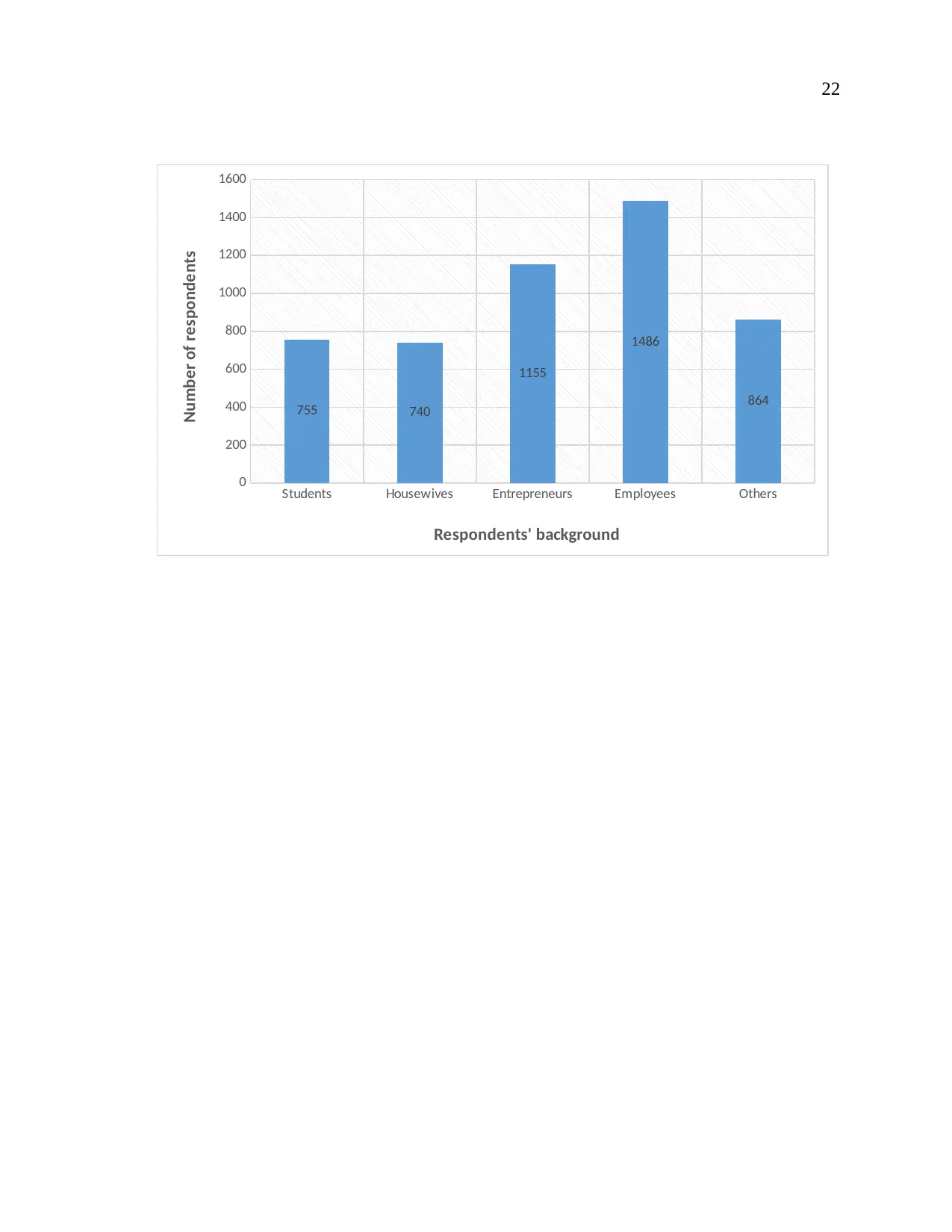
22
Students Housewives Entrepreneurs Employees Others
0
200
400
600
800
1000
1200
1400
1600
755 740
1155
1486
864
Respondents' background
Number of respondents
Students Housewives Entrepreneurs Employees Others
0
200
400
600
800
1000
1200
1400
1600
755 740
1155
1486
864
Respondents' background
Number of respondents
Secure Best Marks with AI Grader
Need help grading? Try our AI Grader for instant feedback on your assignments.
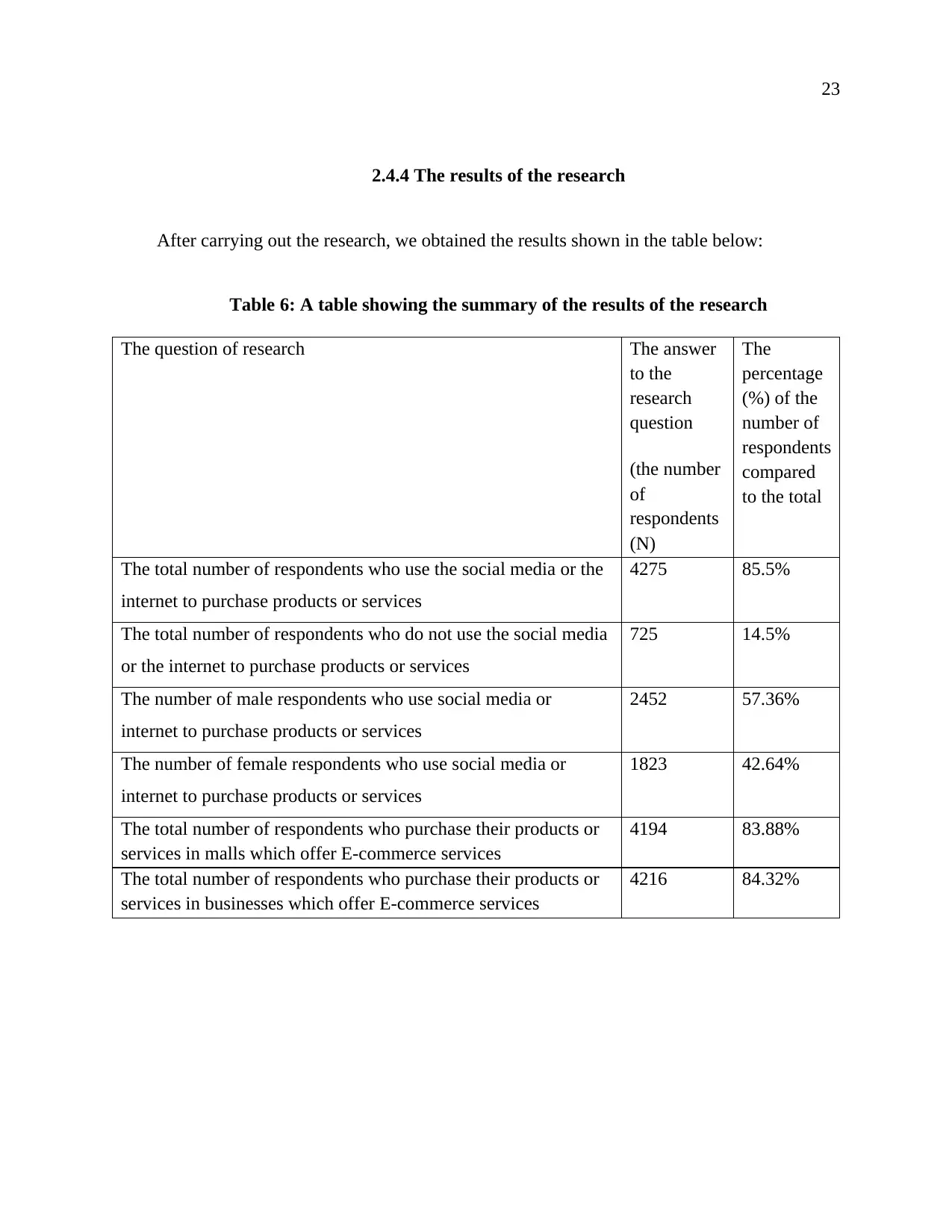
23
2.4.4 The results of the research
After carrying out the research, we obtained the results shown in the table below:
Table 6: A table showing the summary of the results of the research
The question of research The answer
to the
research
question
(the number
of
respondents
(N)
The
percentage
(%) of the
number of
respondents
compared
to the total
The total number of respondents who use the social media or the
internet to purchase products or services
4275 85.5%
The total number of respondents who do not use the social media
or the internet to purchase products or services
725 14.5%
The number of male respondents who use social media or
internet to purchase products or services
2452 57.36%
The number of female respondents who use social media or
internet to purchase products or services
1823 42.64%
The total number of respondents who purchase their products or
services in malls which offer E-commerce services
4194 83.88%
The total number of respondents who purchase their products or
services in businesses which offer E-commerce services
4216 84.32%
2.4.4 The results of the research
After carrying out the research, we obtained the results shown in the table below:
Table 6: A table showing the summary of the results of the research
The question of research The answer
to the
research
question
(the number
of
respondents
(N)
The
percentage
(%) of the
number of
respondents
compared
to the total
The total number of respondents who use the social media or the
internet to purchase products or services
4275 85.5%
The total number of respondents who do not use the social media
or the internet to purchase products or services
725 14.5%
The number of male respondents who use social media or
internet to purchase products or services
2452 57.36%
The number of female respondents who use social media or
internet to purchase products or services
1823 42.64%
The total number of respondents who purchase their products or
services in malls which offer E-commerce services
4194 83.88%
The total number of respondents who purchase their products or
services in businesses which offer E-commerce services
4216 84.32%
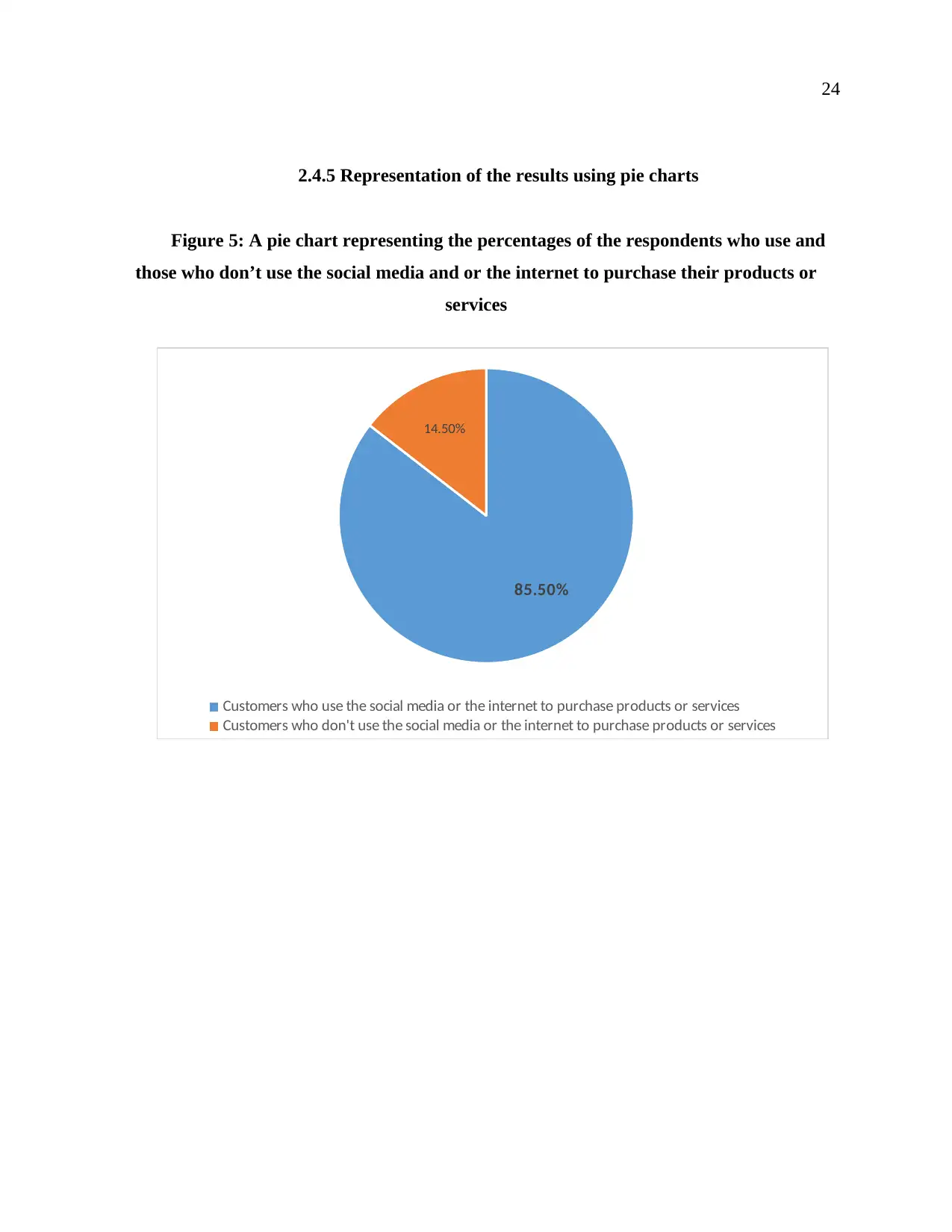
24
2.4.5 Representation of the results using pie charts
Figure 5: A pie chart representing the percentages of the respondents who use and
those who don’t use the social media and or the internet to purchase their products or
services
85.50%
14.50%
Customers who use the social media or the internet to purchase products or services
Customers who don't use the social media or the internet to purchase products or services
2.4.5 Representation of the results using pie charts
Figure 5: A pie chart representing the percentages of the respondents who use and
those who don’t use the social media and or the internet to purchase their products or
services
85.50%
14.50%
Customers who use the social media or the internet to purchase products or services
Customers who don't use the social media or the internet to purchase products or services
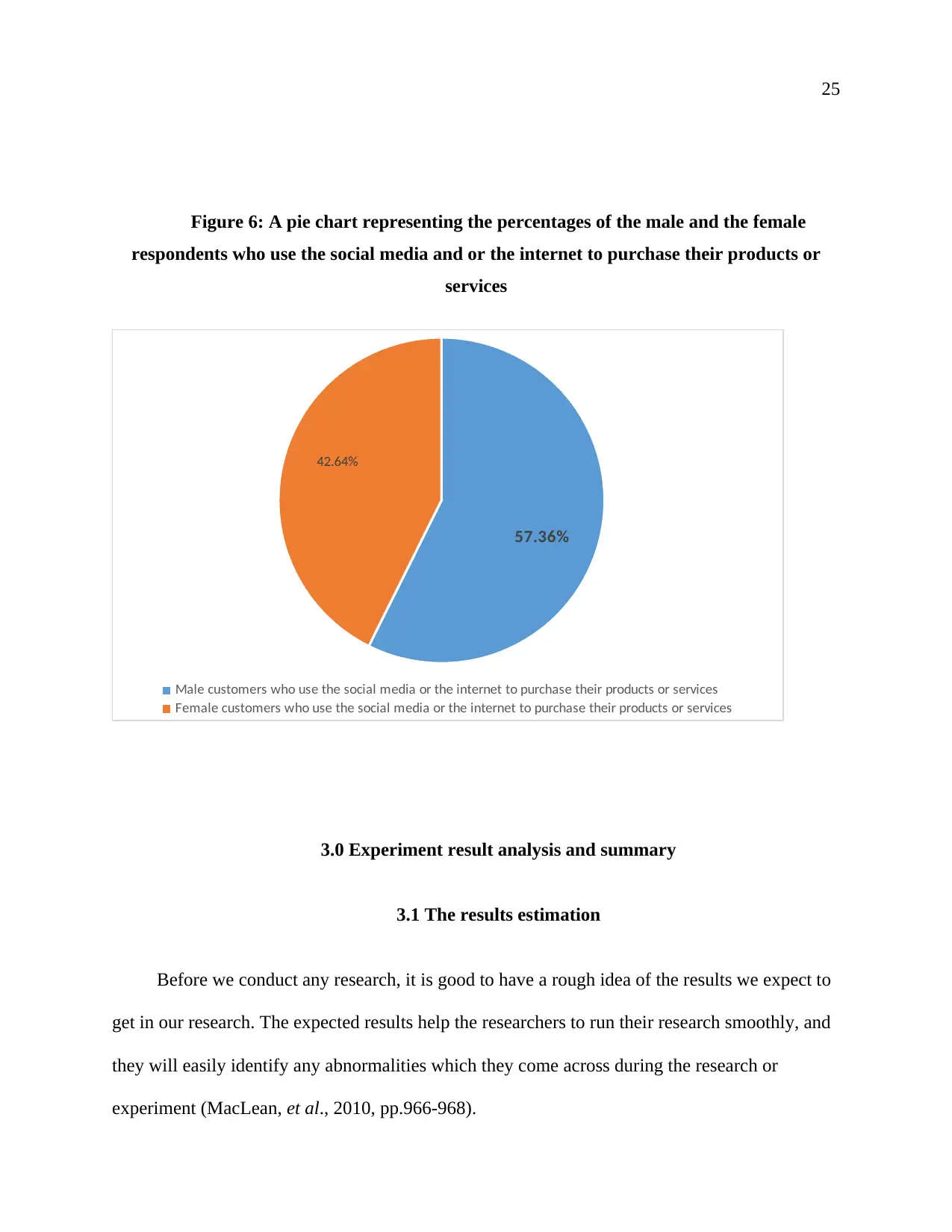
25
Figure 6: A pie chart representing the percentages of the male and the female
respondents who use the social media and or the internet to purchase their products or
services
57.36%
42.64%
Male customers who use the social media or the internet to purchase their products or services
Female customers who use the social media or the internet to purchase their products or services
3.0 Experiment result analysis and summary
3.1 The results estimation
Before we conduct any research, it is good to have a rough idea of the results we expect to
get in our research. The expected results help the researchers to run their research smoothly, and
they will easily identify any abnormalities which they come across during the research or
experiment (MacLean, et al., 2010, pp.966-968).
Figure 6: A pie chart representing the percentages of the male and the female
respondents who use the social media and or the internet to purchase their products or
services
57.36%
42.64%
Male customers who use the social media or the internet to purchase their products or services
Female customers who use the social media or the internet to purchase their products or services
3.0 Experiment result analysis and summary
3.1 The results estimation
Before we conduct any research, it is good to have a rough idea of the results we expect to
get in our research. The expected results help the researchers to run their research smoothly, and
they will easily identify any abnormalities which they come across during the research or
experiment (MacLean, et al., 2010, pp.966-968).
Paraphrase This Document
Need a fresh take? Get an instant paraphrase of this document with our AI Paraphraser
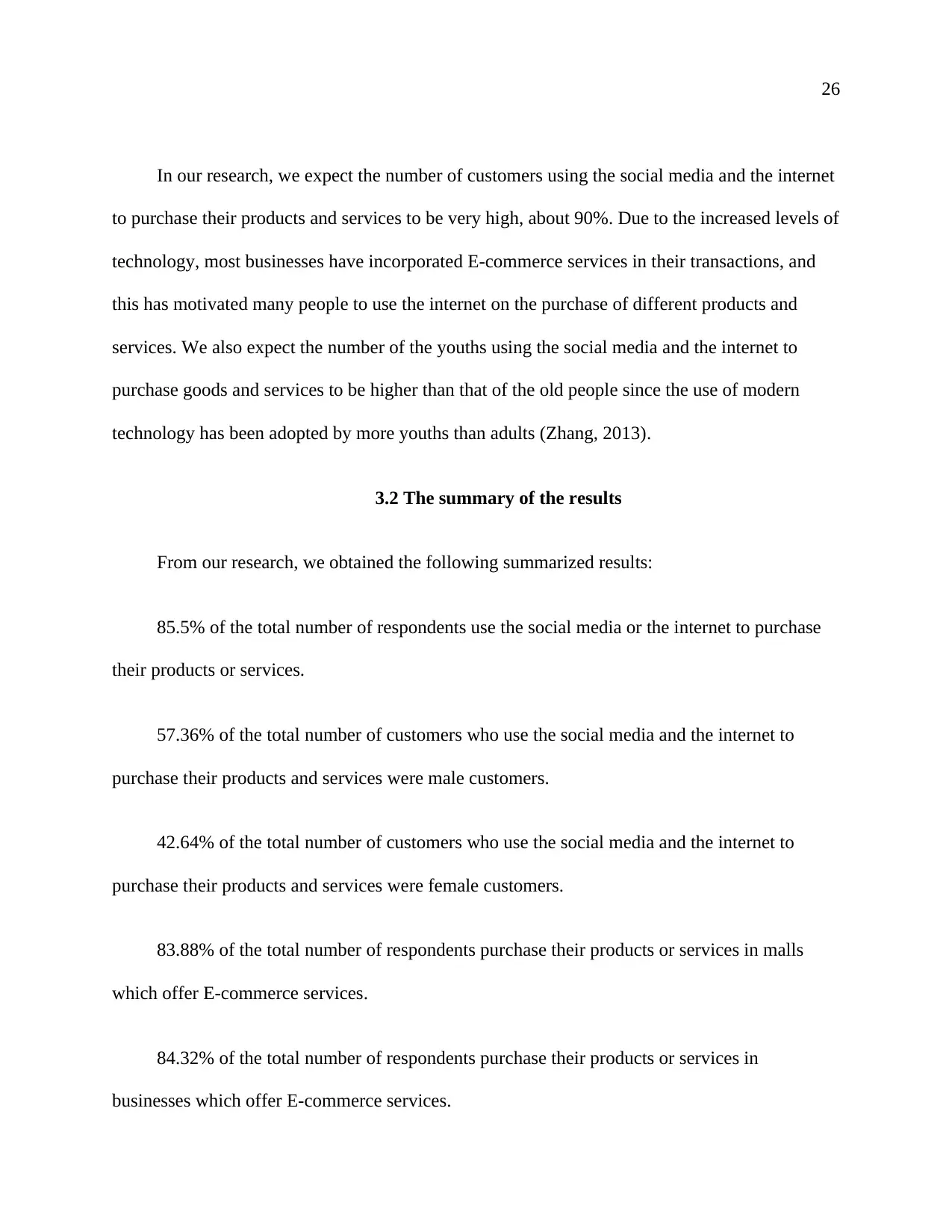
26
In our research, we expect the number of customers using the social media and the internet
to purchase their products and services to be very high, about 90%. Due to the increased levels of
technology, most businesses have incorporated E-commerce services in their transactions, and
this has motivated many people to use the internet on the purchase of different products and
services. We also expect the number of the youths using the social media and the internet to
purchase goods and services to be higher than that of the old people since the use of modern
technology has been adopted by more youths than adults (Zhang, 2013).
3.2 The summary of the results
From our research, we obtained the following summarized results:
85.5% of the total number of respondents use the social media or the internet to purchase
their products or services.
57.36% of the total number of customers who use the social media and the internet to
purchase their products and services were male customers.
42.64% of the total number of customers who use the social media and the internet to
purchase their products and services were female customers.
83.88% of the total number of respondents purchase their products or services in malls
which offer E-commerce services.
84.32% of the total number of respondents purchase their products or services in
businesses which offer E-commerce services.
In our research, we expect the number of customers using the social media and the internet
to purchase their products and services to be very high, about 90%. Due to the increased levels of
technology, most businesses have incorporated E-commerce services in their transactions, and
this has motivated many people to use the internet on the purchase of different products and
services. We also expect the number of the youths using the social media and the internet to
purchase goods and services to be higher than that of the old people since the use of modern
technology has been adopted by more youths than adults (Zhang, 2013).
3.2 The summary of the results
From our research, we obtained the following summarized results:
85.5% of the total number of respondents use the social media or the internet to purchase
their products or services.
57.36% of the total number of customers who use the social media and the internet to
purchase their products and services were male customers.
42.64% of the total number of customers who use the social media and the internet to
purchase their products and services were female customers.
83.88% of the total number of respondents purchase their products or services in malls
which offer E-commerce services.
84.32% of the total number of respondents purchase their products or services in
businesses which offer E-commerce services.
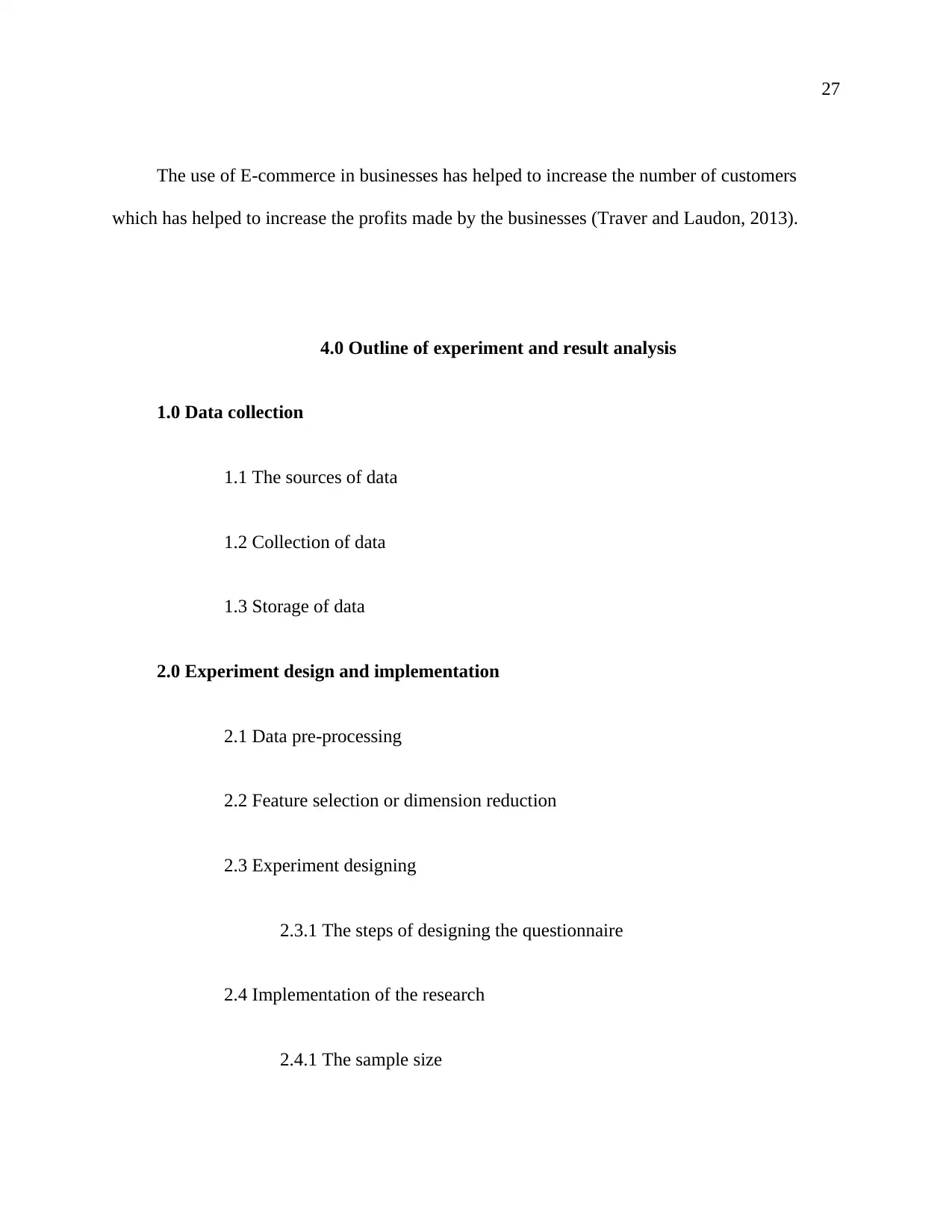
27
The use of E-commerce in businesses has helped to increase the number of customers
which has helped to increase the profits made by the businesses (Traver and Laudon, 2013).
4.0 Outline of experiment and result analysis
1.0 Data collection
1.1 The sources of data
1.2 Collection of data
1.3 Storage of data
2.0 Experiment design and implementation
2.1 Data pre-processing
2.2 Feature selection or dimension reduction
2.3 Experiment designing
2.3.1 The steps of designing the questionnaire
2.4 Implementation of the research
2.4.1 The sample size
The use of E-commerce in businesses has helped to increase the number of customers
which has helped to increase the profits made by the businesses (Traver and Laudon, 2013).
4.0 Outline of experiment and result analysis
1.0 Data collection
1.1 The sources of data
1.2 Collection of data
1.3 Storage of data
2.0 Experiment design and implementation
2.1 Data pre-processing
2.2 Feature selection or dimension reduction
2.3 Experiment designing
2.3.1 The steps of designing the questionnaire
2.4 Implementation of the research
2.4.1 The sample size
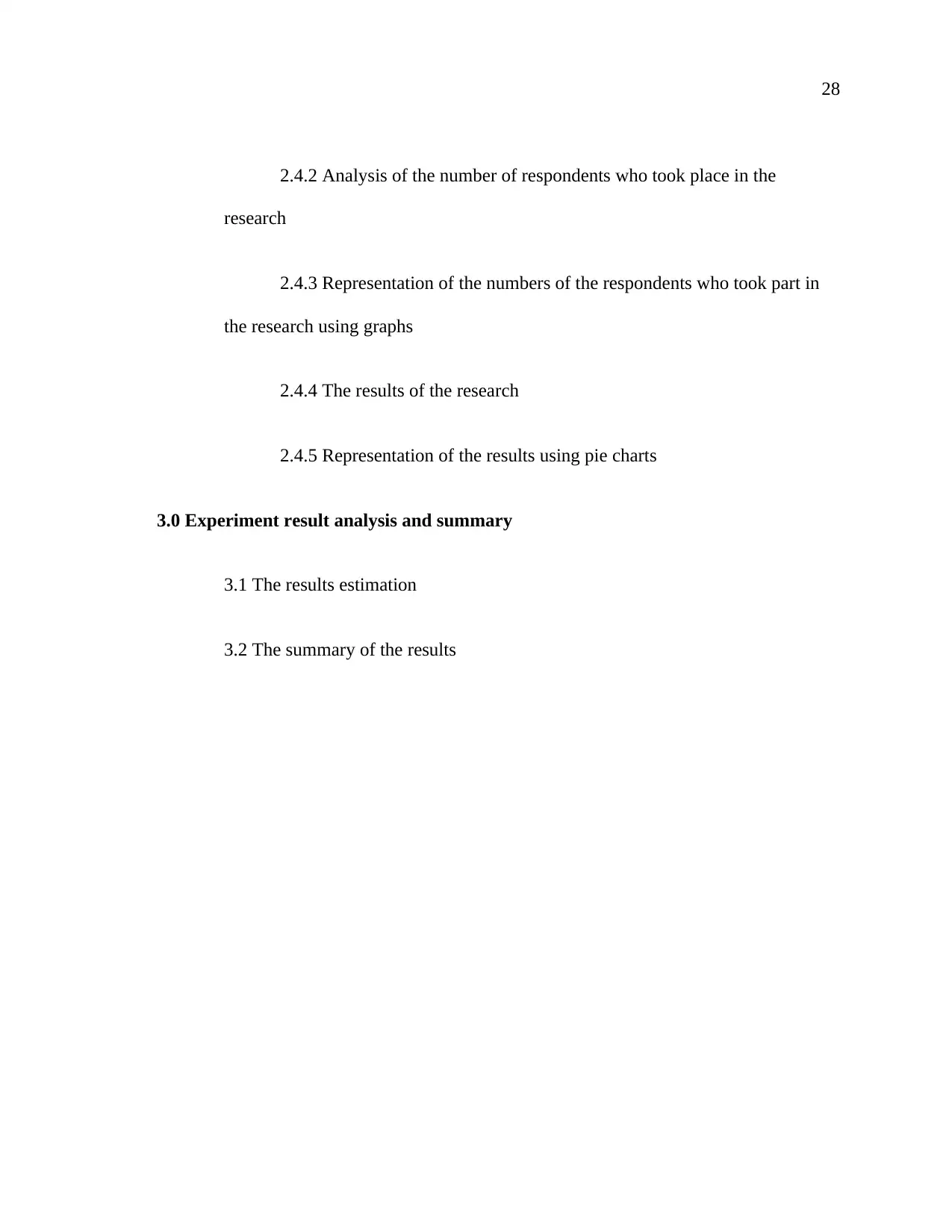
28
2.4.2 Analysis of the number of respondents who took place in the
research
2.4.3 Representation of the numbers of the respondents who took part in
the research using graphs
2.4.4 The results of the research
2.4.5 Representation of the results using pie charts
3.0 Experiment result analysis and summary
3.1 The results estimation
3.2 The summary of the results
2.4.2 Analysis of the number of respondents who took place in the
research
2.4.3 Representation of the numbers of the respondents who took part in
the research using graphs
2.4.4 The results of the research
2.4.5 Representation of the results using pie charts
3.0 Experiment result analysis and summary
3.1 The results estimation
3.2 The summary of the results
Secure Best Marks with AI Grader
Need help grading? Try our AI Grader for instant feedback on your assignments.
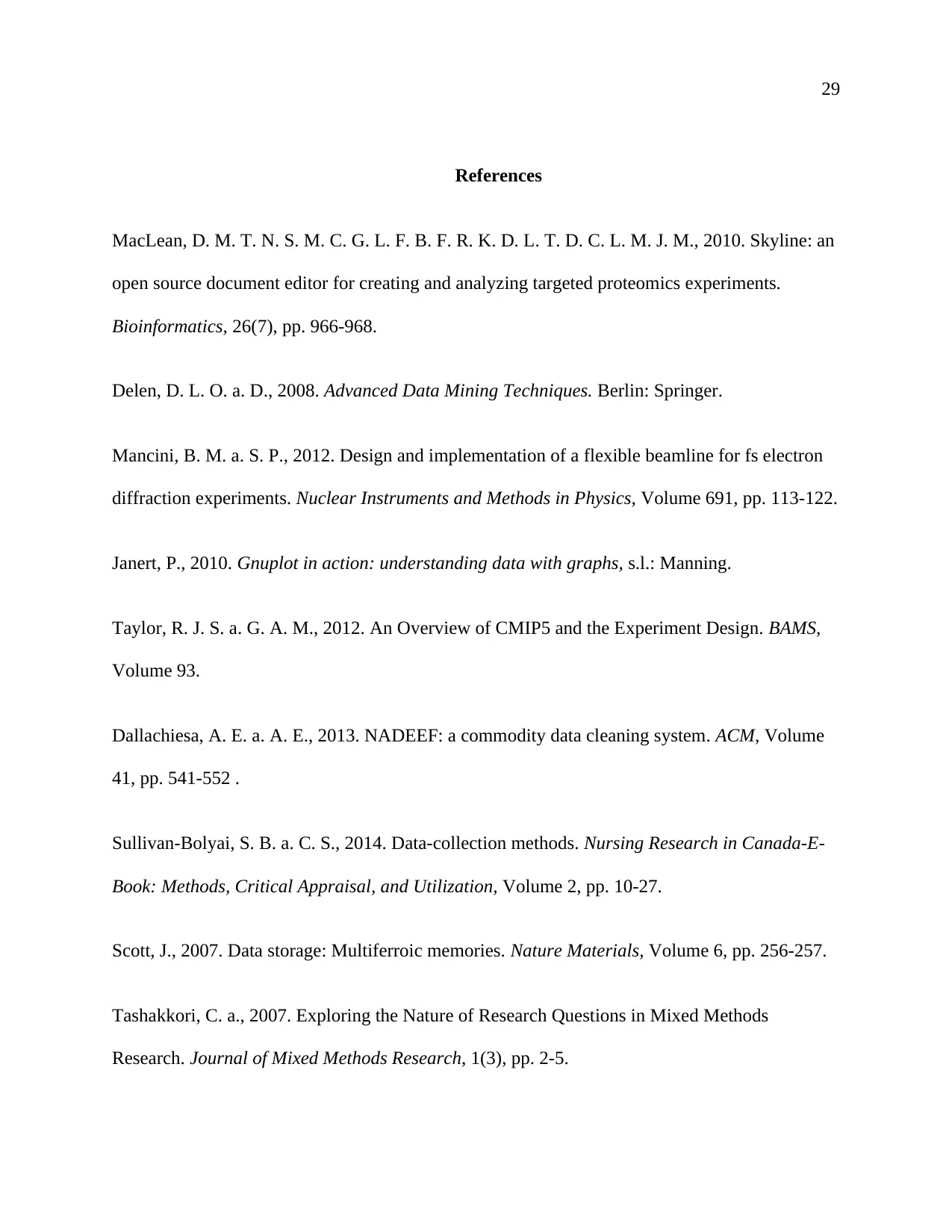
29
References
MacLean, D. M. T. N. S. M. C. G. L. F. B. F. R. K. D. L. T. D. C. L. M. J. M., 2010. Skyline: an
open source document editor for creating and analyzing targeted proteomics experiments.
Bioinformatics, 26(7), pp. 966-968.
Delen, D. L. O. a. D., 2008. Advanced Data Mining Techniques. Berlin: Springer.
Mancini, B. M. a. S. P., 2012. Design and implementation of a flexible beamline for fs electron
diffraction experiments. Nuclear Instruments and Methods in Physics, Volume 691, pp. 113-122.
Janert, P., 2010. Gnuplot in action: understanding data with graphs, s.l.: Manning.
Taylor, R. J. S. a. G. A. M., 2012. An Overview of CMIP5 and the Experiment Design. BAMS,
Volume 93.
Dallachiesa, A. E. a. A. E., 2013. NADEEF: a commodity data cleaning system. ACM, Volume
41, pp. 541-552 .
Sullivan-Bolyai, S. B. a. C. S., 2014. Data-collection methods. Nursing Research in Canada-E-
Book: Methods, Critical Appraisal, and Utilization, Volume 2, pp. 10-27.
Scott, J., 2007. Data storage: Multiferroic memories. Nature Materials, Volume 6, pp. 256-257.
Tashakkori, C. a., 2007. Exploring the Nature of Research Questions in Mixed Methods
Research. Journal of Mixed Methods Research, 1(3), pp. 2-5.
References
MacLean, D. M. T. N. S. M. C. G. L. F. B. F. R. K. D. L. T. D. C. L. M. J. M., 2010. Skyline: an
open source document editor for creating and analyzing targeted proteomics experiments.
Bioinformatics, 26(7), pp. 966-968.
Delen, D. L. O. a. D., 2008. Advanced Data Mining Techniques. Berlin: Springer.
Mancini, B. M. a. S. P., 2012. Design and implementation of a flexible beamline for fs electron
diffraction experiments. Nuclear Instruments and Methods in Physics, Volume 691, pp. 113-122.
Janert, P., 2010. Gnuplot in action: understanding data with graphs, s.l.: Manning.
Taylor, R. J. S. a. G. A. M., 2012. An Overview of CMIP5 and the Experiment Design. BAMS,
Volume 93.
Dallachiesa, A. E. a. A. E., 2013. NADEEF: a commodity data cleaning system. ACM, Volume
41, pp. 541-552 .
Sullivan-Bolyai, S. B. a. C. S., 2014. Data-collection methods. Nursing Research in Canada-E-
Book: Methods, Critical Appraisal, and Utilization, Volume 2, pp. 10-27.
Scott, J., 2007. Data storage: Multiferroic memories. Nature Materials, Volume 6, pp. 256-257.
Tashakkori, C. a., 2007. Exploring the Nature of Research Questions in Mixed Methods
Research. Journal of Mixed Methods Research, 1(3), pp. 2-5.
1 out of 29
Related Documents
Your All-in-One AI-Powered Toolkit for Academic Success.
+13062052269
info@desklib.com
Available 24*7 on WhatsApp / Email
![[object Object]](/_next/static/media/star-bottom.7253800d.svg)
Unlock your academic potential
© 2024 | Zucol Services PVT LTD | All rights reserved.





